Most Popular Cover Collections of 2017
1. Salute to the 50 States
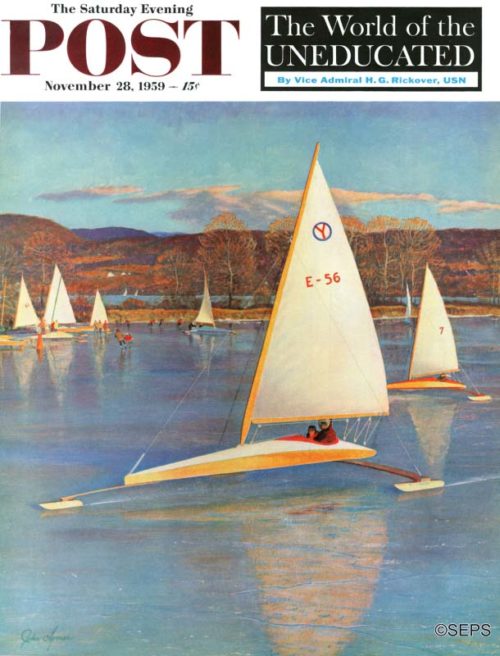
Sailboats
John Clymer
November 28, 1959
From the lighthouses of Maine to the majestic Cascades of Oregon, The Saturday Evening Post has represented every state on its cover. Here are 50 of our favorites. (Apparently they were your favorites, too!)
2. Back to School
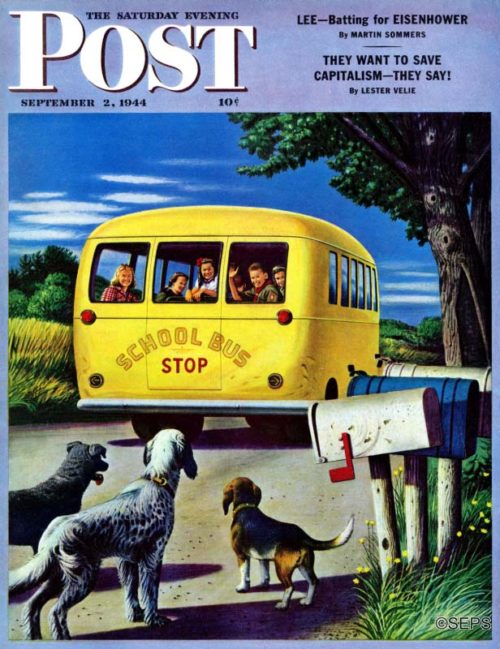
Stevan Dohanos
September 2, 1944
Classrooms may have changed from pencils to PowerPoint, but our magazine has always been there to witness sending our kids back to school.
3. Tee Time
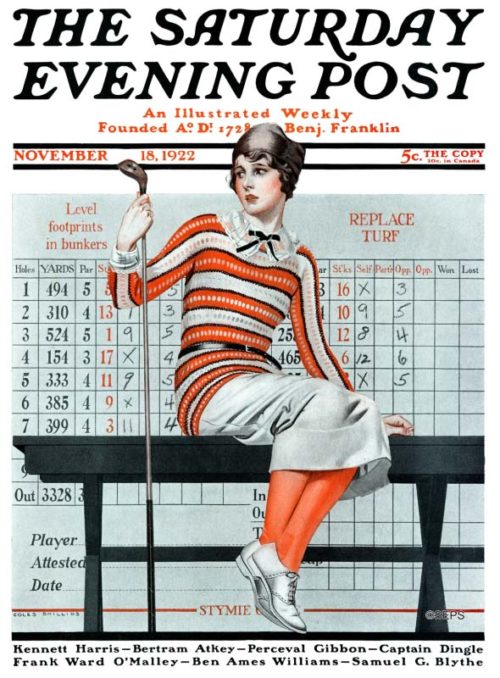
Coles Phillips
November 11, 1922
These covers show that golf is much more than a good walk spoiled. (It s a good day spoiled.)
4. Fall Video Gallery: Vintage Baseball Covers
Artist John Falter brought the fall season to life through his many covers for The Saturday Evening Post. This video highlights some of our favorites.
5. The Best Santas Ever
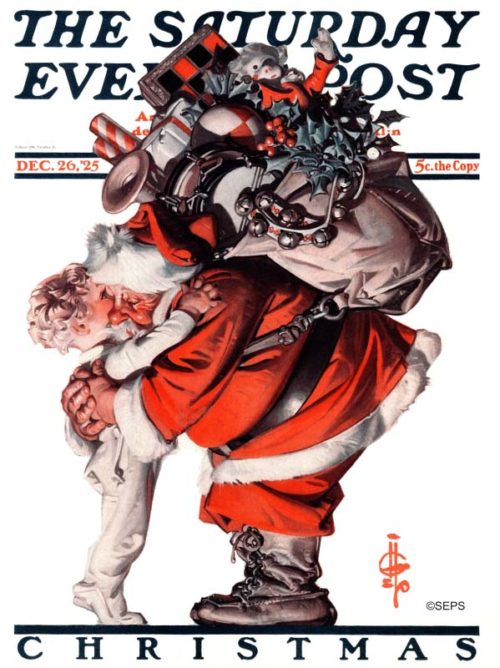
J. C. Leyendecker
December 26, 1925
Over the decades, we’ve featured iconic images of Santa Claus on our December covers. Famed illustrators Norman Rockwell and J.C. Leyendecker created some of the most cherished depictions of St. Nick.
6. Time for Pie
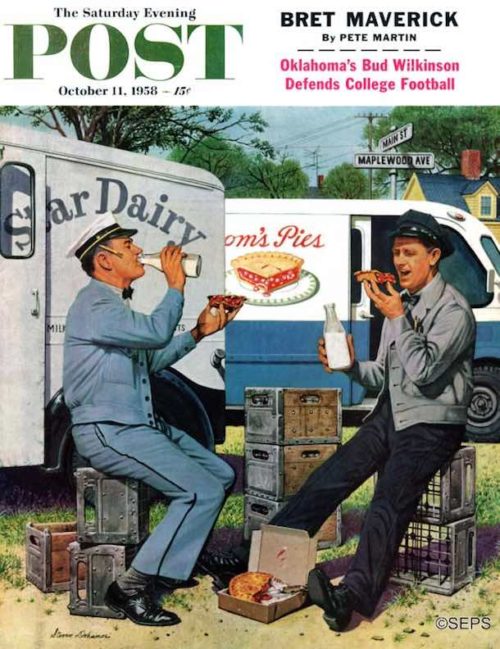
Stevan Dohanos
October 11, 1958
Pie follows closely on the heels of turkey as the quintessential Thanksgiving dish. These pies plus recipes will inspire your pursuit of pastry.
7. Presidents
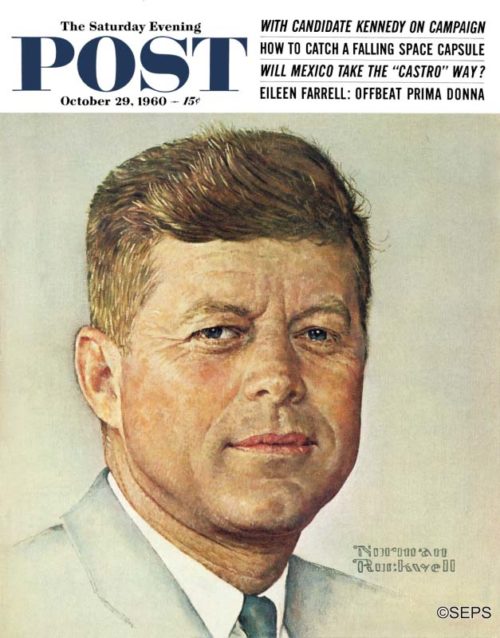
By Norman Rockwell
October 29, 1960
From Grover Cleveland to Richard Nixon, The Saturday Evening Post featured many U.S. presidents on its covers in its nearly 200-year history.
8. Celebrating America
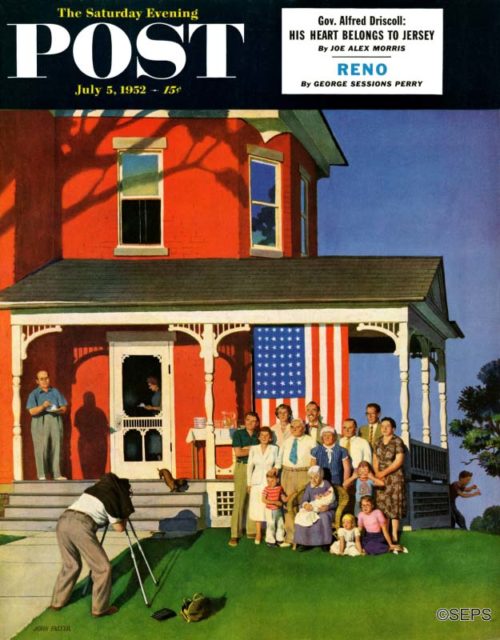
John Falter
July 5, 1952
With fluttering flags and steadfast soliders, the Post has honored the land of the free and the home of the brave.
9. Travel Nightmares
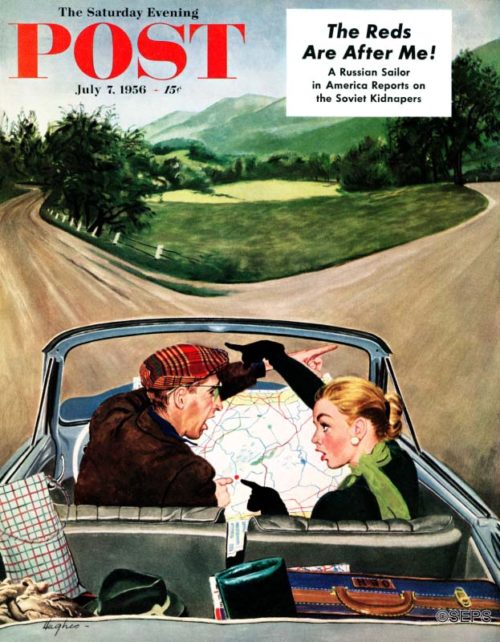
George Hughes
July 7, 1956
These illustrations of jaunts gone wrong might make you re-think that summer road trip.
10. Congrats, Graduates!
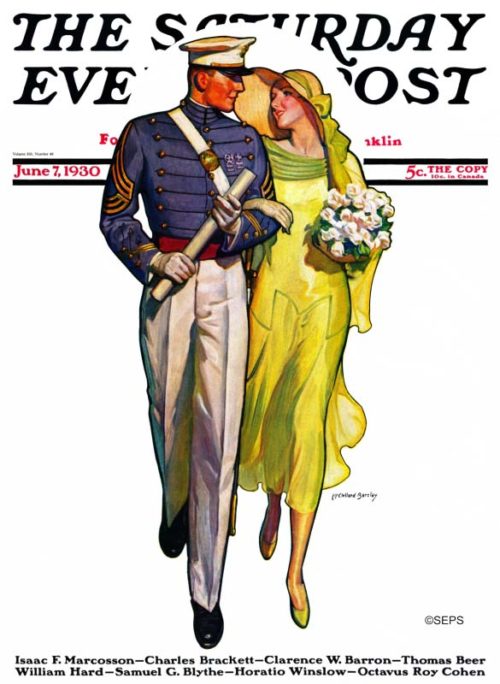
McClelland Barclay
June 7, 1930
This moment of accomplishment has made frequent appearances on our covers, starting more than a hundred years ago.
Cover Gallery: Bridal Wave
June means the start of wedding season. These Post covers show beautiful brides of the twentieth century.
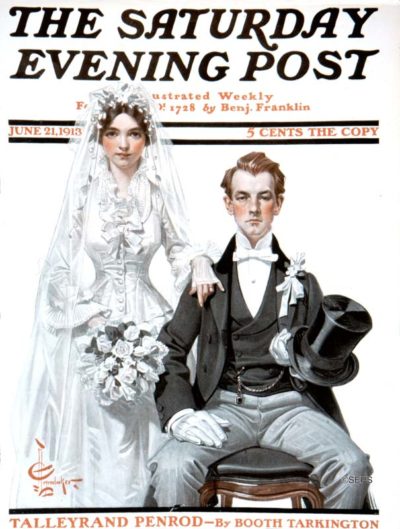
J. C. Leyendecker
June 21, 1913
In this painting by prolific artist J.C. Leyendecker, he shows a solemn couple having their photograph taken. Leyendecker illustrated the nuptial moments of other pairs, including Romeo and Juliet and Henry V and Catherine Valois. It appears this couple has got the “wedded” part down, if not the “bliss.”
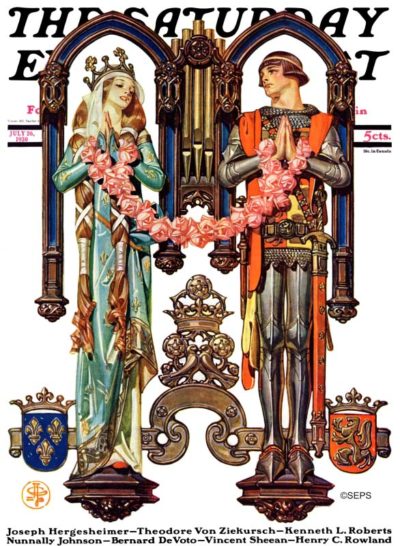
July 26, 1930
J.C. Leyendecker
Catherine of Valois married Henry V in June of 1420 and later gave birth to Henry VI. Henry V died shortly after his son’s birth, leaving the young Catherine a widow and her infant son the King of England.
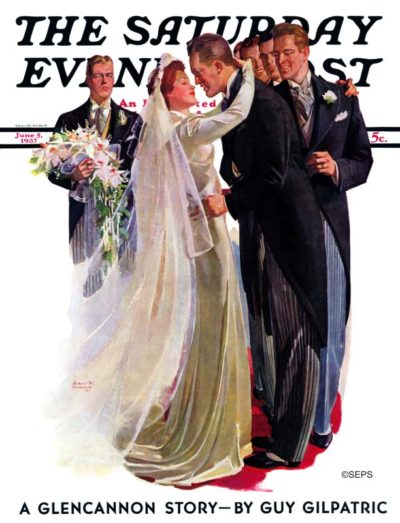
Albert W. Hampson
June 5, 1937
The groom doesn’t look too happy about this scenario. Given the line of enthusiastic groomsmen, the bride may not have enough energy for the honeymoon.
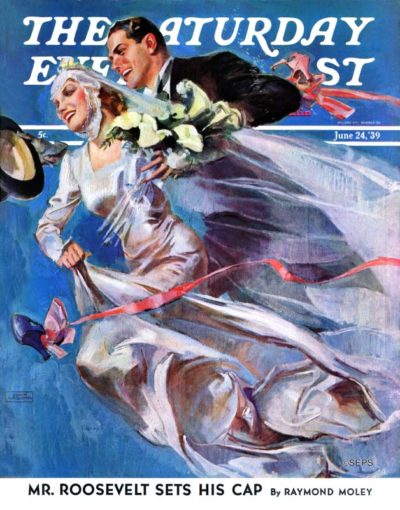
John LaGatta
June 24, 1939
LaGatta had an uncanny knack for translating from model to canvas an appreciation and sensual perspective of the female figure. LaGatta began his artistic process by sketching the models in charcoal and pastels and then would almost always refine his interpretation into an oil painting. His subjects were sophisticated, upper-class men and women with long graceful figures and with classic clothing designs. His images gave the impression that the models didn’t have a care in the world, as in this 1939 cover of a couple running off after their wedding ceremony.
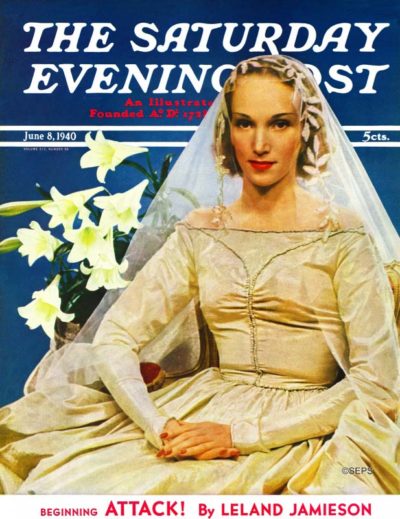
Wynn Richards
June 8, 1940
This 1940 bridal photograph was Wynn Richards’ one and only cover for the Saturday Evening Post. Richards was born “Martha Kinman Wynn” before marrying Dorsey Eugene Richards, according to her biography.. She opened her own photography studio in 1919, but left the business to a friend after a social scandal that involved her taking nude portraits of a local school teacher. Richards divorced her husband and left their son with his grandmother before opening a new portrait studio a few years later. Initially signing her work “Matsy Wynn Richards,” she learned that revealing her gender could hinder her career, and changed her signature to “Wynn Richards.” Richard’s work mostly appeared in Vogue, Harper’s Bazaar, and Mademoiselle magazine.
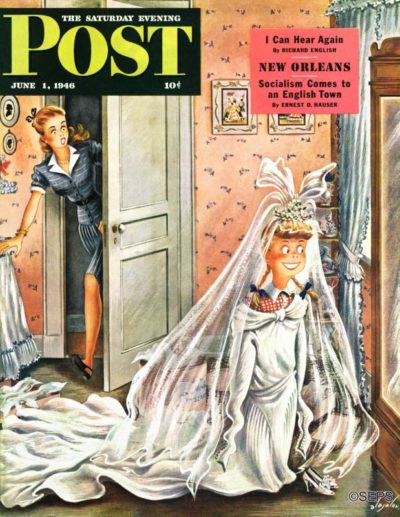
Constantin Alajalov
June 1, 1946
[From the editors of the June 1, 1946 issue of the Post] Just after Constantin Alajalov finished his kid-sister painting, he set out from New York for Florida, to work on other cover assignments. The artist went by automobile, and sent back a short report on his three-day journey. The highways are full of displaced persons at the moment, sorting themselves out after the great disruption of war, and we think Alajalov’s account is a thumbnail picture of America in Transition. “The first day,” he wrote, “I picked up a corporal just back from Tokyo, hitch-hiking to Alabama to marry a girl there. The second day I picked up a marine hitch-hiking to Jacksonville, Florida, to get his wife. The third day I picked up a sailor who was going to Miami for any girl he could get.”
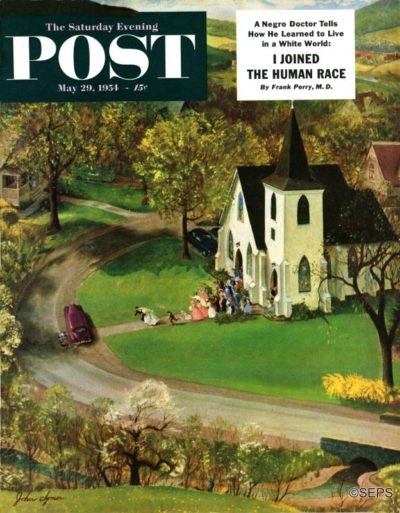
May 29, 1954
John Clymer
[From the editors of the May 29, 1954 Post] Away go the newly-marrieds into their brave new world and thank heaven it isn’t raining. John Clymer is nice about weather; on his covers it hardly ever rains. That church, says Clymer, is located in one state and the landscape in another state, and the honeymoon will take place in the state of bliss always visited on such trips.
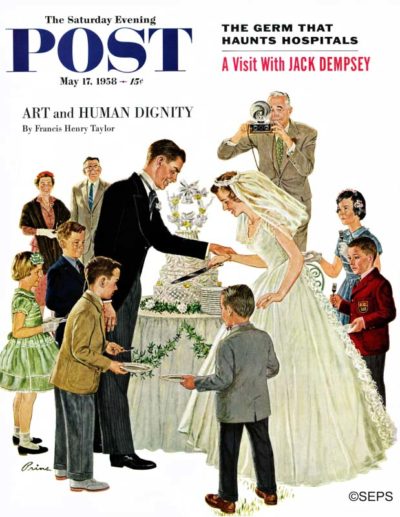
May 17, 1958
Ben Prins
[From the editors of the May 17, 1958 Post] Here come the bride and groom to carve the cake. Two-handed carving isn’t an efficient way to dismember food, but He and She have just become One and this is the tender symbol of their unity. They probably aren’t hungry; in a day or two food will become attractive, but right now they are not of this world, they are up in the clouds, in a state of bliss where folks subsist on love alone. Conversely, those youngsters have their feet on the ground and their eyes on the cake. Oh, the girls may save a few crumbs to put under their pillows to incite romantic dreaming, but the boys will put their cake where it belongs, and let’s hope they don’t consume enough to turn dreams into nightmares. Well, a toast to artist Ben Prins’ newlyweds: bon voyage, all the way through life!
Cover Gallery: The Armed Forces
In celebration of Armed Forces Day, we share our favorite covers featuring the brave people who served our country.
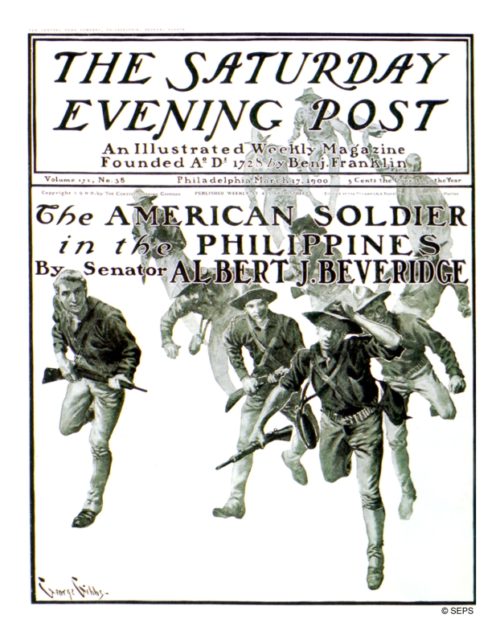
March 17, 1900
George Gibbs
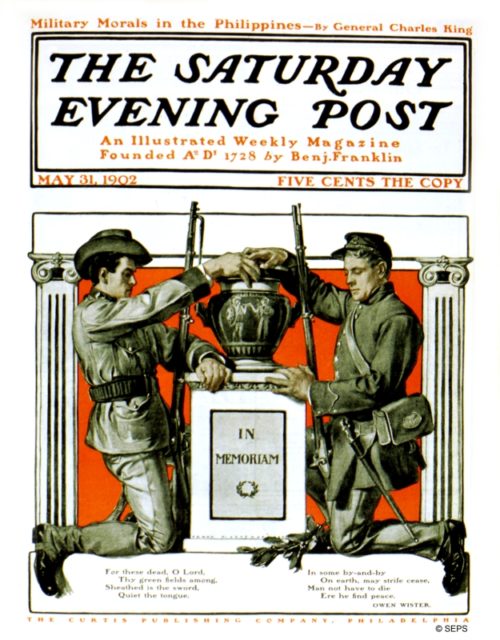
May 31, 1902
Frank X. Leyendecker
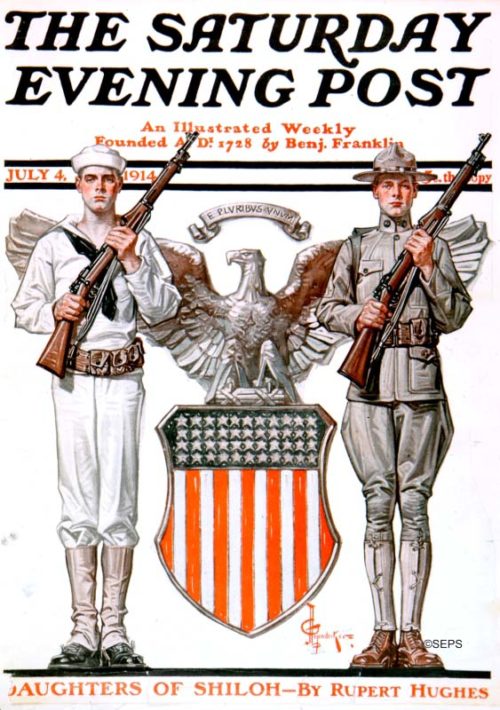
July 4, 1914
J. C. Leyendecker
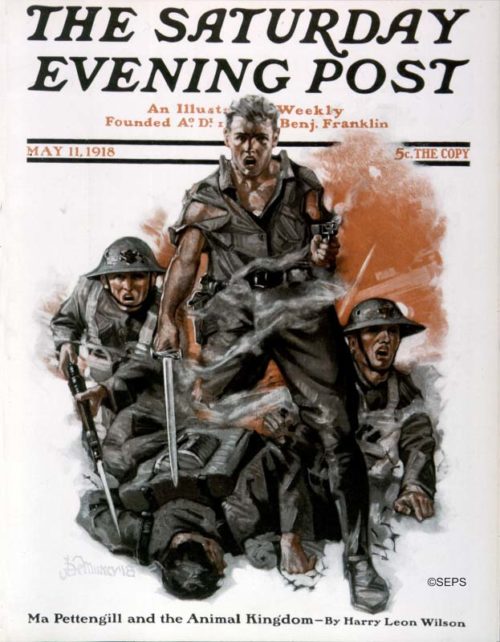
May 11, 1918
Julian De Miskey
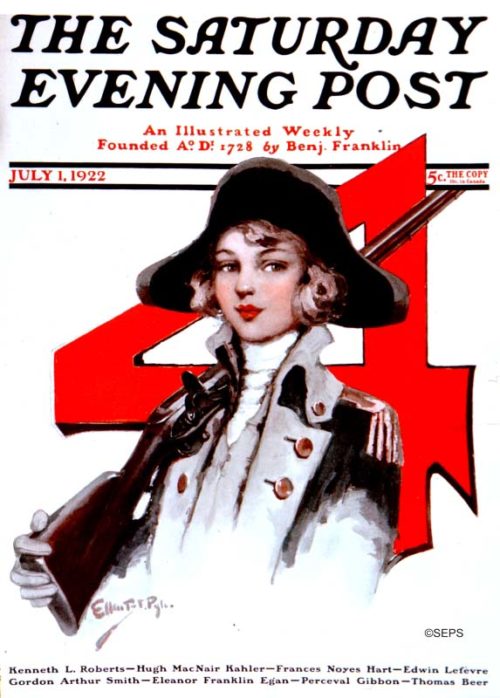
July 1, 1922
Ellen Pyle
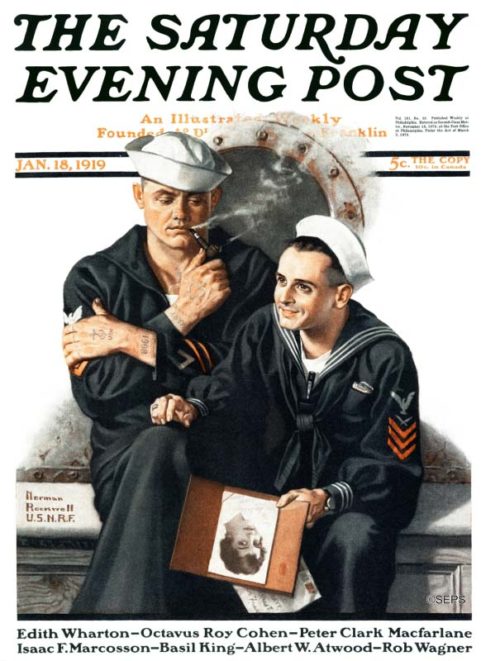
January 18, 1919
Norman Rockwell
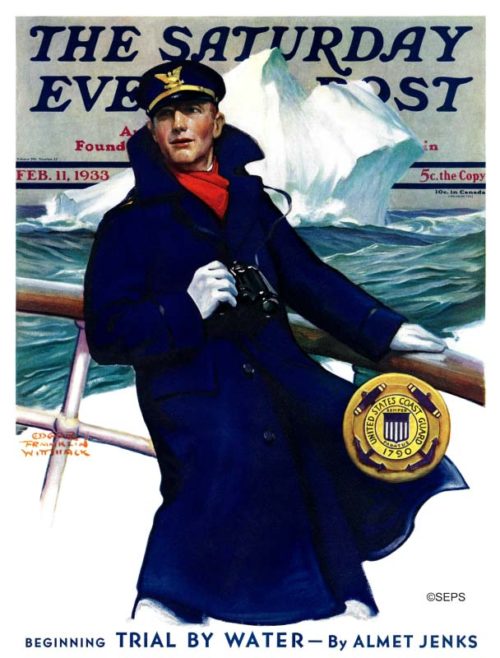
February 11, 1943
Edgar Franklin Wittmack
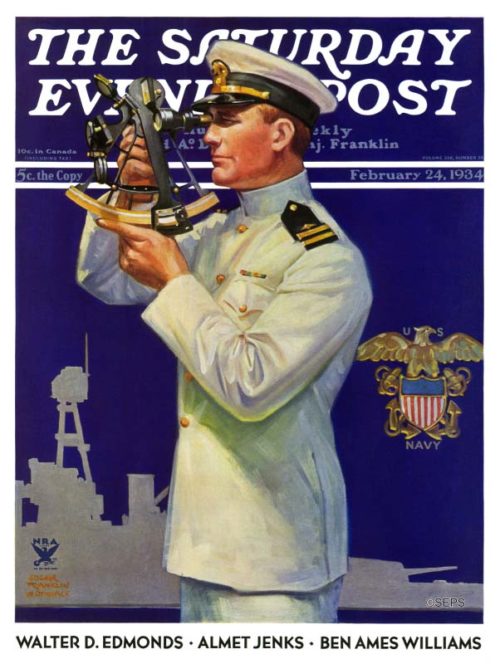
February 24, 1934
Edgar Franklin Wittmack
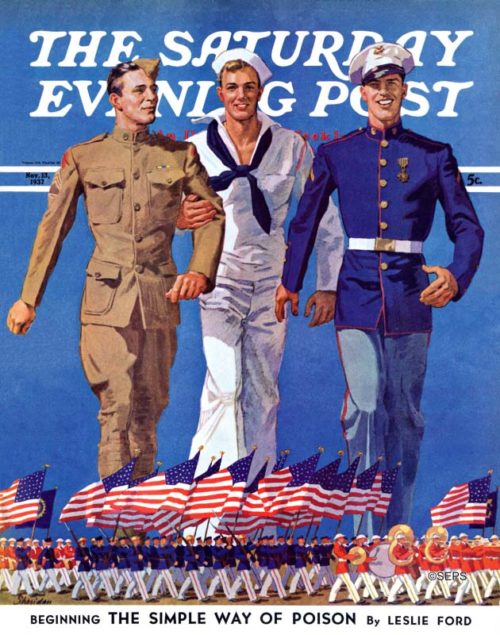
November 13, 1937
John E. Sheridan
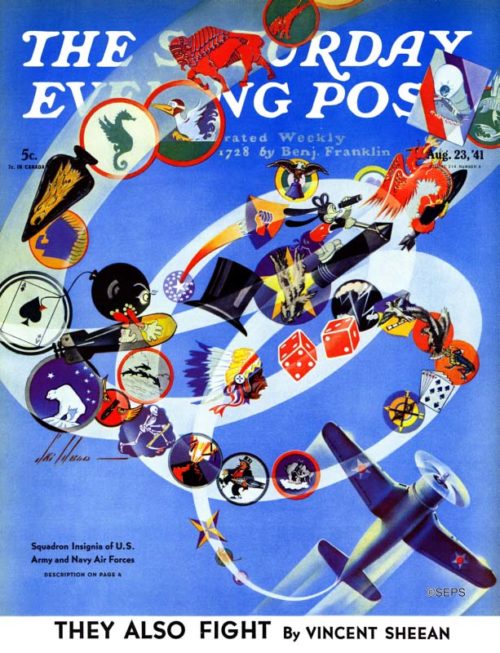
August 23, 1941
Ski Weld
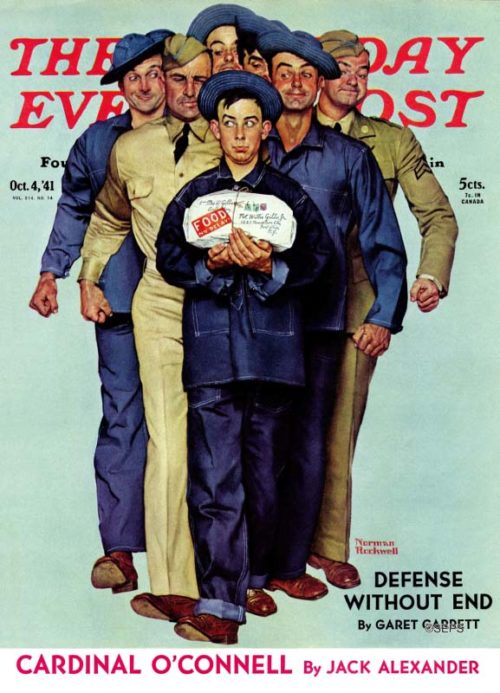
October 4, 1941
Norman Rockwell
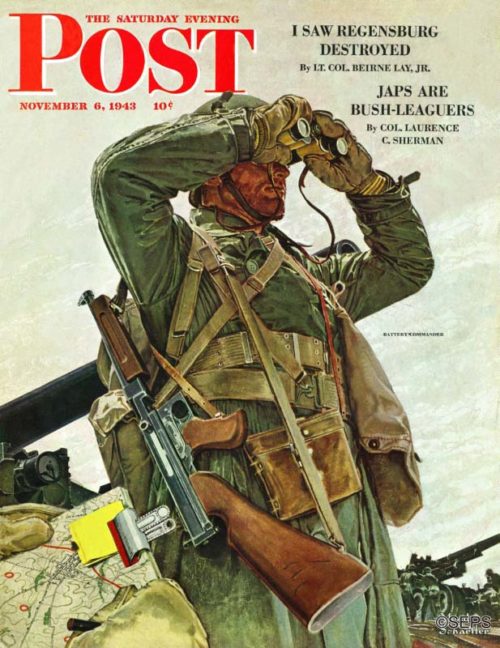
November 6, 1943
Mead Schaeffer
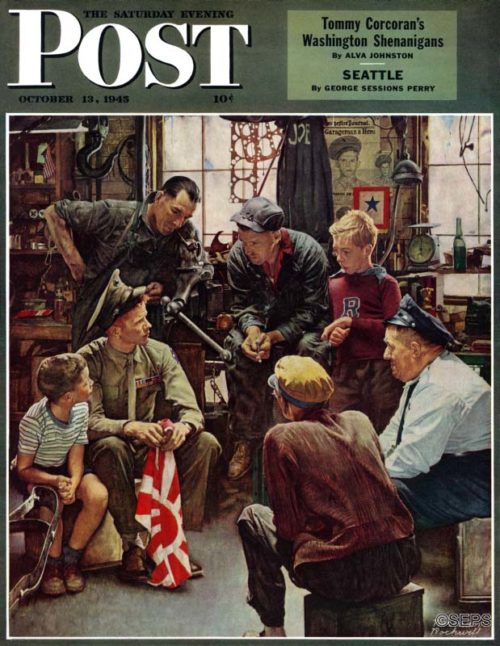
October 13, 1945
Norman Rockwell
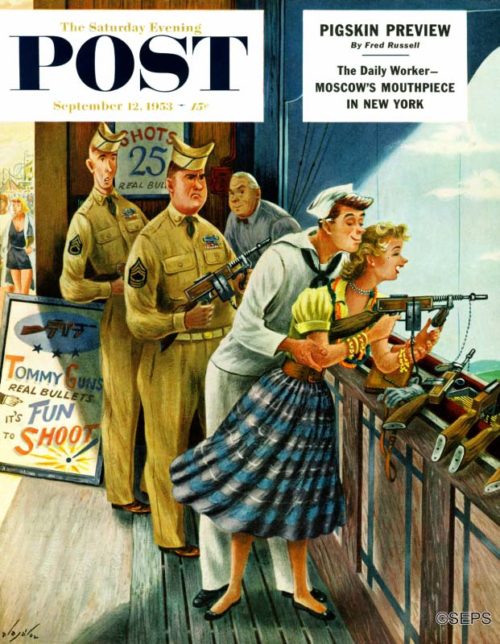
September 12, 1953
Constantin Alajalov
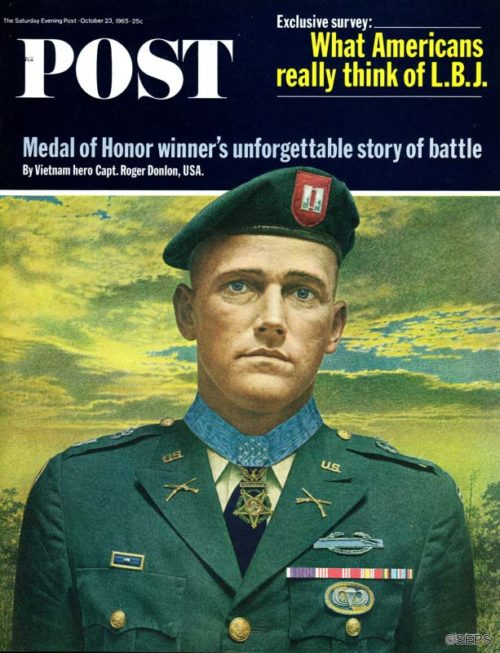
October 23, 1965
Jean L. Huens
Cover Gallery: Rainy Days
The weather may be dreary, but these rainy day covers will make you feel cheery!
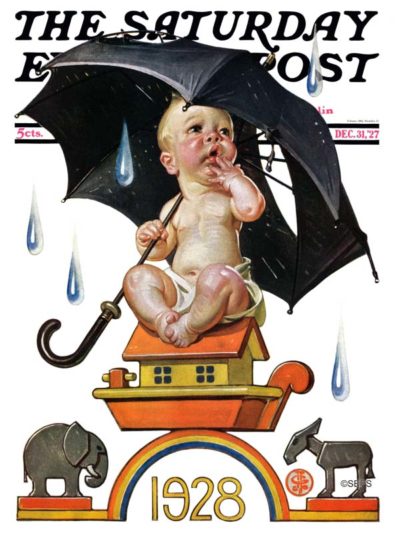
December 31, 1927
J. C. Leyendecker
Artist J. C. Leyendecker was well known for his Baby New Year illustrations that graced many Post covers from the 1910s through the 1940s. Our 1928 baby awaits the possible repeal of Prohibition, symbolized by “wet” weather.
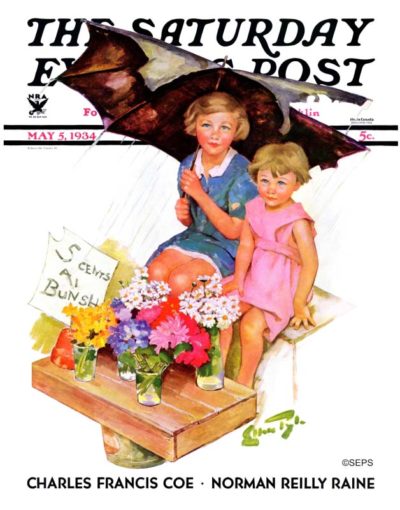
Ellen Pyle
May 4, 1934
The subjects in this illustration were likely artist Ellen Pyle’s own children; they served as the models in more than 20 of her Post covers.
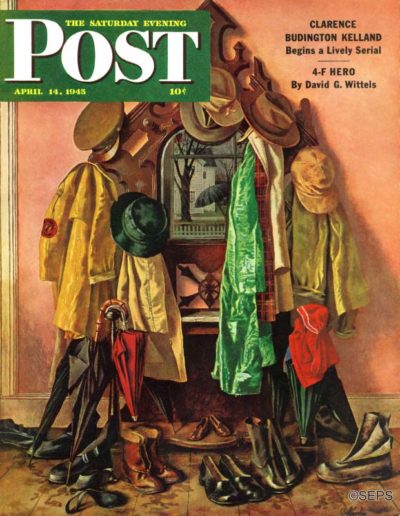
John Atherton
April 14th, 1945
[From the editors of the April 14, 1945 issue] Norman Rockwell suggested the idea to Atherton. The hatrack is in the hall of the Community House at Arlington, Vermont. Neighbors contributed the hats, coats and galoshes seen in the painting.
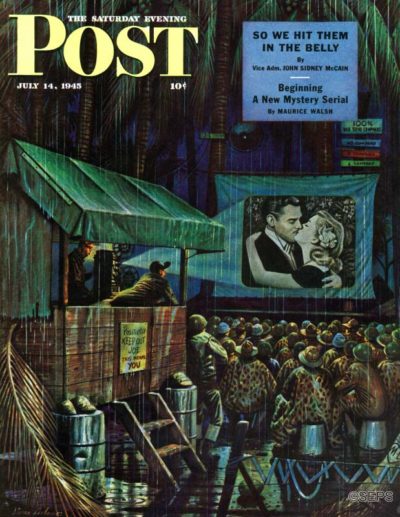
Stevan Dohanos
July 17, 1945
[From the editors of the July 17, 1945 issue] We imagine it is hard for anyone who has never sat on a Pacific spit kit of an island for months on end, contemplating the shapely curves of a can of tinned-pork products for emotional release, to understand Stevan Dohanos’ cover. After such soul-gnawing, a flickering, one-dimensional pin-up girl enlarged many times on an improvised screen must have the pulling power a naked electric-light bulb has for a moth. Most South Pacific movies are now first-run, sometimes world premieres; but when “Wilson” was shown on Okinawa before an audience just back from the front lines, there were eight air-raid interruptions, and the show assumed a three-and-a-half-hour Gone With the Wind proportion. Perhaps the reason why Dohanos’ G.I.’s are willing to sit in the rain is that their bucket seats are really magic carpets taking them home to Main Street for an hour or two.
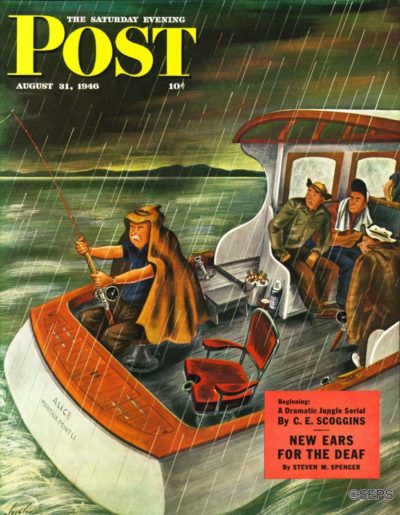
Constantin Alajalov
August 31, 1946
[From the editors of the August 31, 1946 issue] The man who has determined to go fishing, Constantin Alajalov observed when he was in Florida, will go fishing until he catches a fish, in spite of bad weather. Alajalov determined to paint this truth. There were a few things on which he needed to refresh his recollection, but to do this, he needed only to go out in a boat on a similar day. We don’t know how long the average determined fisherman has to wait for a sunny day. We do know how long Alajalov had to wait to catch a rainy one. One fair day followed another. He waited three weeks.
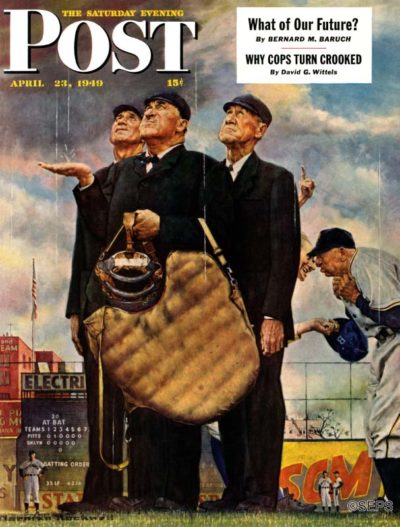
Norman Rockwell
April 23, 1949
[From the editors of the April 23, 1949 issue] This week’s Norman Rockwell cover depicts Ebbets Field, the home of the Brooklyn Dodgers. Here, the Dodgers are trailing the Pittsburgh Pirates 1-0 in the sixth inning. If the arbiters—left to right, Harry Goetz, Beans Reardon and Lou Jorda—call the game because of rain, the score will stand as is, and Pittsburgh will win. This irks the Brooklynites, who dislike having other teams win. In the picture, Clyde Sukeforth, a Brooklyn coach, could well be saying, “You may be all wet, but it ain’t raining a drop!” The huddled
Pittsburgher—Bill Meyer, Pirate manager—is doubtless retorting, “For the love of Abner Doubleday, how can we play ball in this cloudburst?”
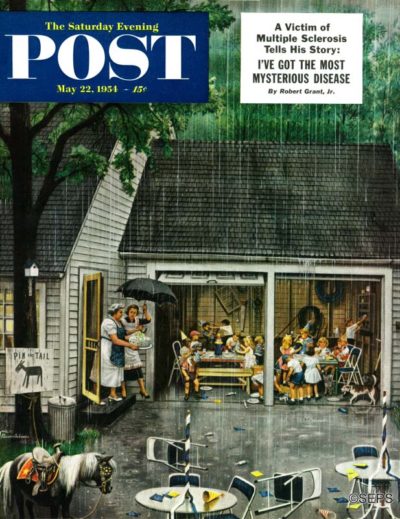
Stevan Dohanos
May 22, 1954
[From the editors of the May 22, 1954 issue] Rather than be depressed by Mr. Dohanos’ soggy scene, note how the deluge has improved the situation. Any birthday party is fun, even if nothing more happens than the duly expected games, grub and slight fights between incompatible little boys. But to arrange for the routine confusion to be stepped up into the joyous chaos of a garden party dispersed by a cloudburst, that’s a charming innovation indeed. And how delightful it is to throw a party in or into a garage, where tools and other weapons are available for favors as well as paper hats, where joy can he so much more unconfined than in an ordinary living-room hullabaloo. Even that pony thinks, Bless the rain—no more work. Fortunately, there isn’t space here for what mother thinks.
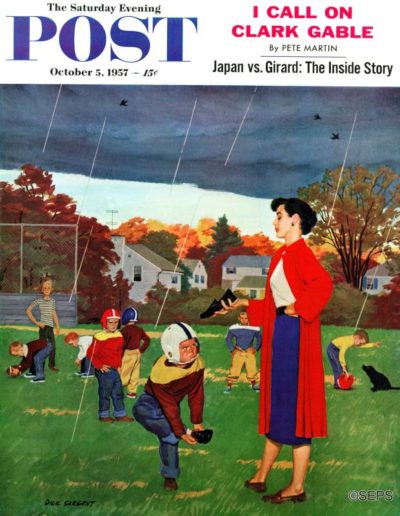
Richard Sargent
October 5, 1957
[From the editors of the October 5, 1957 issue] Women can be such a handicap sometimes—“Aw, ma, halfbacks don’t wear rubbers. Next thing, you’ll want me to make touchdowns with my poncho on. Next thing, you’ll want me to run the end with an umbrella.” To which mother replies, “James, football men obey the quarterback’s signals or get benched. The bench is home. Now then, four, eleven, forty-four, hip—on rubbers!” Well, the maxim says that mothers know best, and if James catches cold by getting wet everywhere except his feet, let’s switch to the maxim that only Monday-morning quarterbacks think of everything. This might have been some action picture if Dick Sargent hadn’t rung in mother; yet let’s settle for the maxim that when it comes to painting, painters know best.
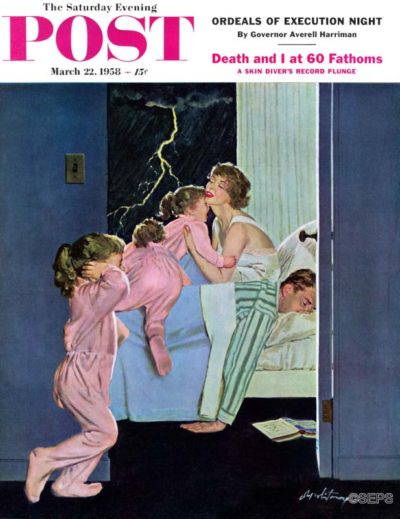
Coby Whitmore
March 22, 1958
[From the editors of the March 22, 1958 issue] Of course, the children haven’t been frightened by Papa’s snoring, but by the awful sounds of Nature on an electrical rampage. So mother will gather them in her arms and love away their fear—mustn’t it be wonderful to be a mother? If that lightning is bedeviling a far-north state, it should signify the breaking up of a winter which certainly needed breaking up; and yet not long ago some northern areas had thunderstorms followed by the blankety-blankest descent of snow for thirty-something years. Let’s leave forecasting to the weatherman, who is welcome to it. Coby Whitmore’s man of the house, buried there in the bed, must be the deepest sleeper this side of the proverbial log. How does mother get him up mornings—rap on his head with the book?
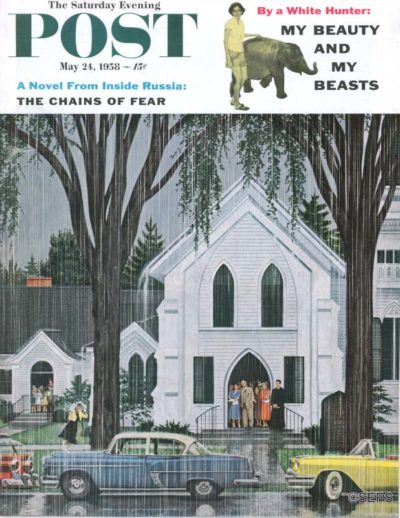
Melbourne E. Brindle
May 24, 1958
[From the editors of the May 25, 1958 issue] This wet cover had its origin in a drought. When crops withered in the Eastern states last summer, the Rev. Benjamin Axleroad, seen there at the door of St. Mark’s Episcopal Church in Bridgewater, Conn., included in his prayers a plea for precipitation. And one Sunday, just as his service ended, down came the rain, exit drought. Weeks later artist Melbourne Brindle, a St. Mark’s vestryman, puzzled some of the congregation by posing them at the church and refusing to tell them what it was all about—surprise, folks, you’re in the Post! Comments on the cover scene: (l) artistic license helped keep that grass green during the drought; (2) if any of the parishioners were out on a golf course during the deluge, how remorseful they must have been that they weren’t in church.
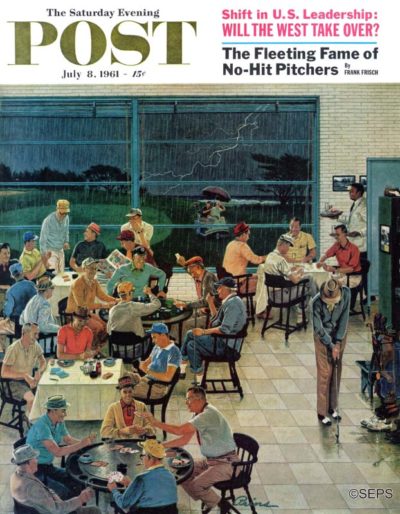
Ben Kimberly Prins
July 8, 1961
[From the editors of the July 8, 1961 issue] How do you like that? On Saturday afternoon—prime time at any golf club—comes the deluge. Well, that’s par for the course, we suppose, and the course in this Ben Prins cover belongs to The Dunes Club of Myrtle Beach, South Carolina. That wave in the background is a fringe of the Atlantic Ocean, not the crest of an oncoming flood. The three-wheeled vehicle under the umbrella is what is known as a caddy car, and its occupants are either fair-weather athletes scurrying toward the indoor recreation of the nineteenth hole, or spirited souls bent on challenging their fellow duffers to a game of motorized water polo. At any rate they’re not slowing down at the putting green. The weather being what it is, they’re probably less concerned about sinking putts than about sinking, period.
Cover Gallery: Love
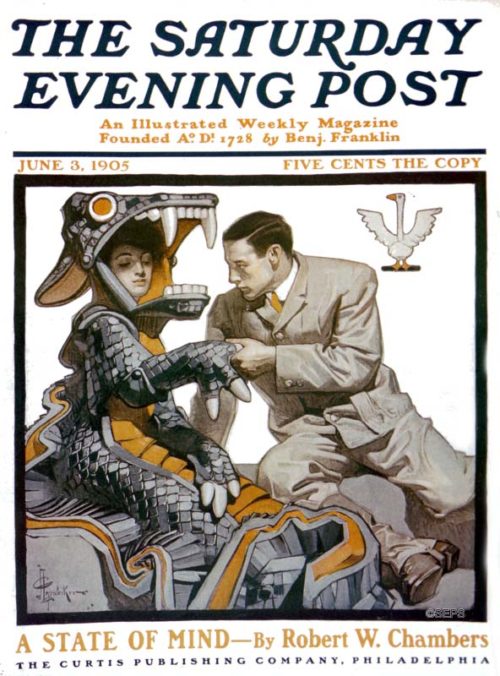
J. C. Leyendecker
June 3, 1905
Nothing says “I love you” like dressing up in a dragon costume.
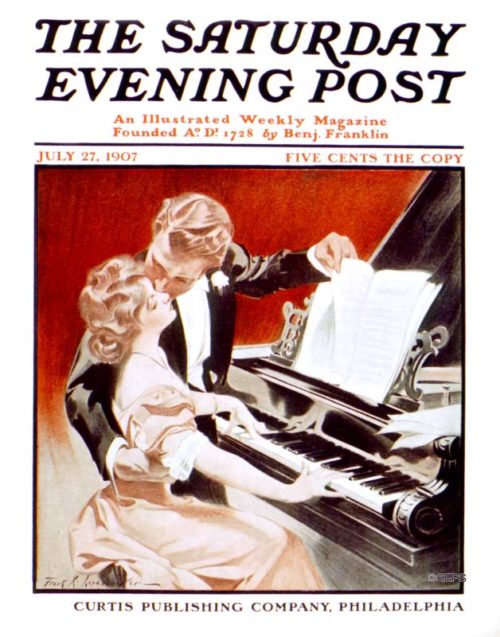
Frank X. Leyendecker
June 27, 1907
Make his heart skip a beat with a beautiful song.
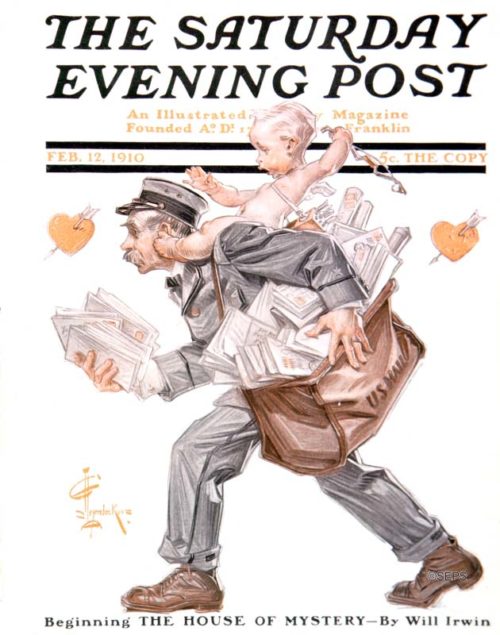
J. C. Leyendecker
February 2, 1910
As Valentine’s Day nears, the Postman and his partner do their best to deliver your love letters on time.
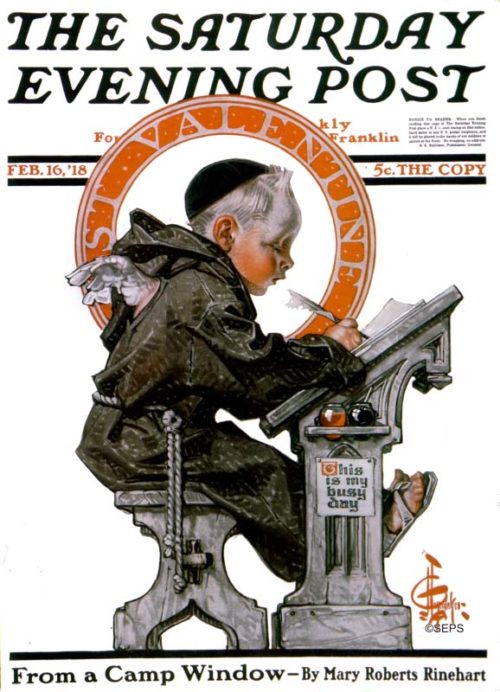
J. C. Leyendecker
February 16, 1918
Love letters don’t write themselves. St. Valentine pens the perfect poem for your paramour.
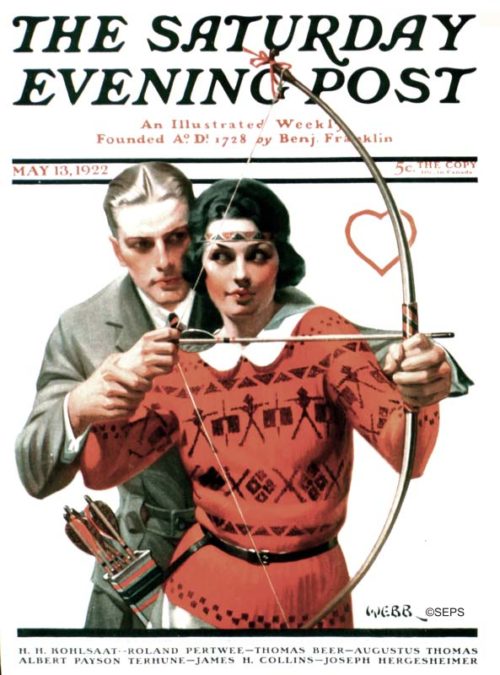
Tom Webb
May 13, 1922
This love struck couple doesn’t need cupid to pierce their hearts.
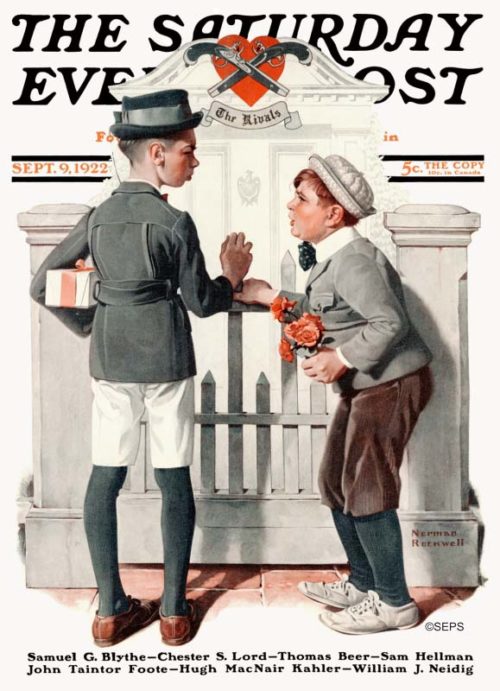
Norman Rockwell
September 9, 1922
Lining up for love is one of many life lessons these lads will encounter.
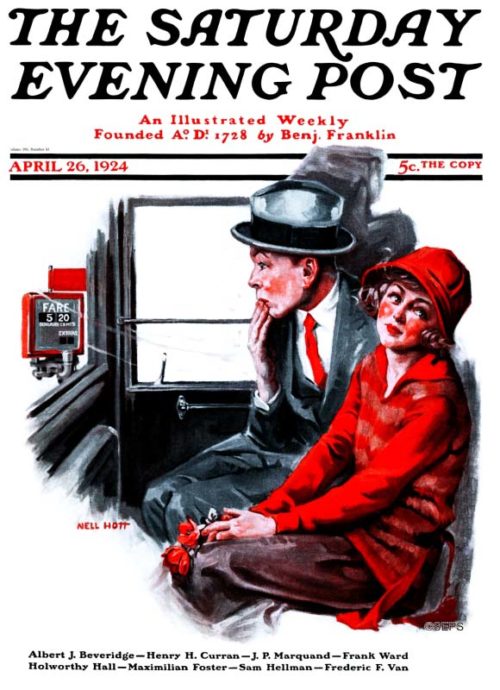
Neil Hott
April 26, 1924
Stretching your last dollar is a simple sacrifice for a romantic night on the town.
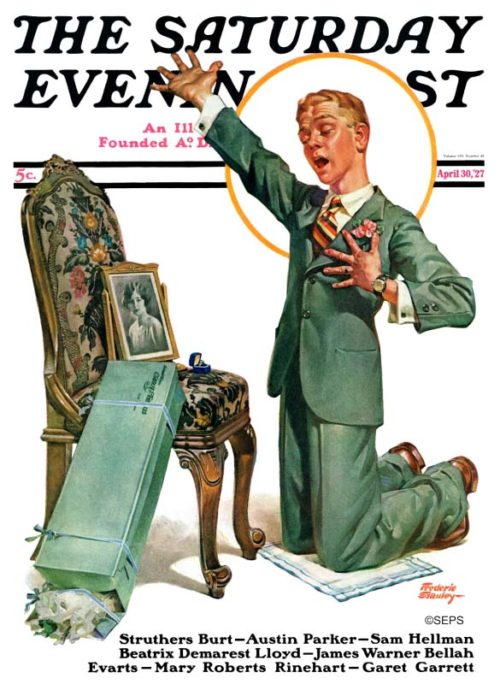
Frederic Stanley
April 30, 1927
Popping the question requires the utmost preparation.
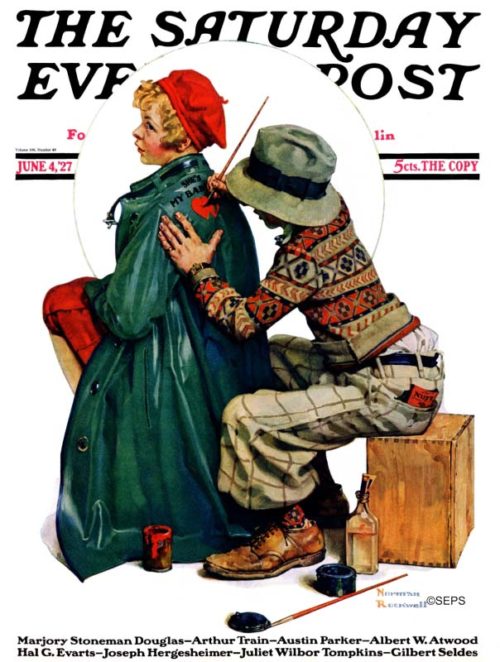
Norman Rockwell
June 4, 1927
This young man hopes to paint his way right into her heart.
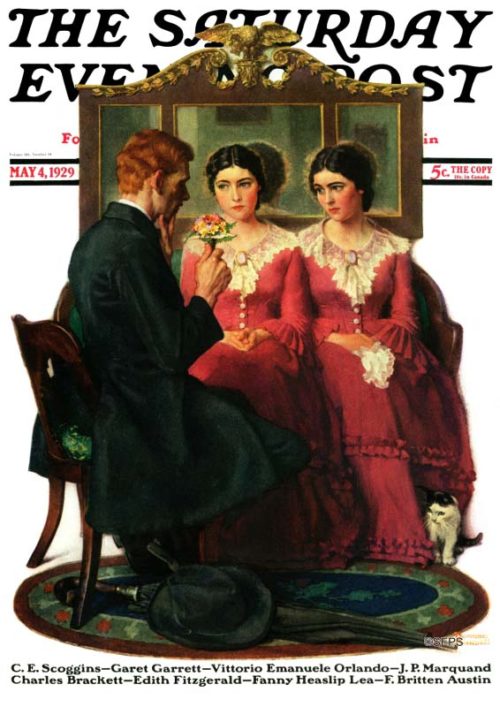
Norman Rockwell
May 4, 1929
A love triangle calls for pretty flowers, but perhaps he should have brought a second bouquet!
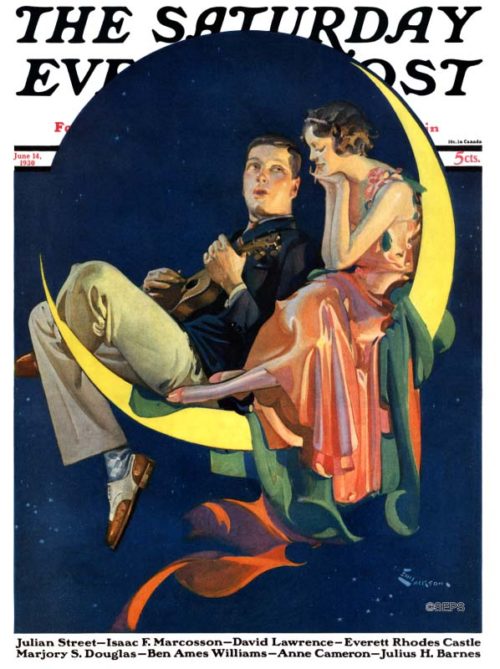
M. Jackson
June 14, 1930
A serenade so stunning, she was over the moon.
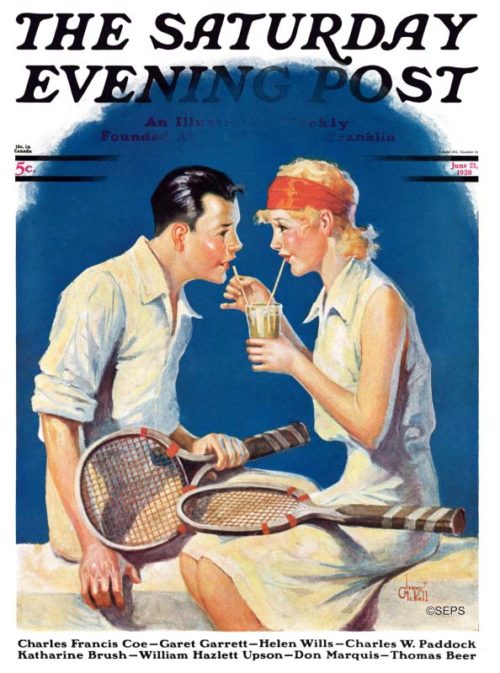
James C. McKell
June 21, 1930
A sweet treat to top off a playful tennis match.
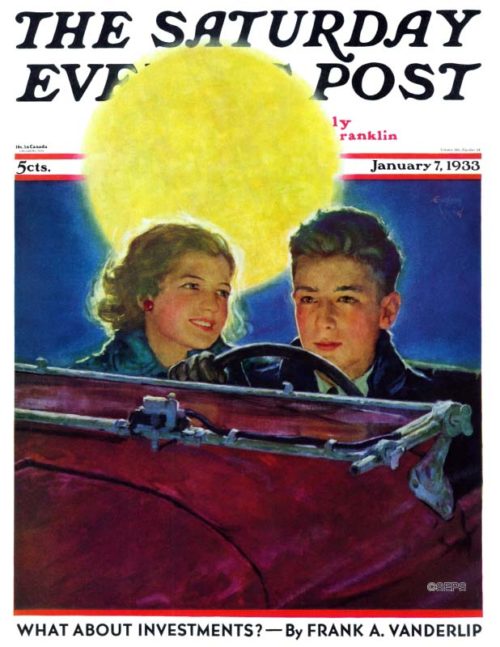
Eugene Iverd
January 7, 1933
The boy of her dreams is even more breathtaking under the glowing moon.
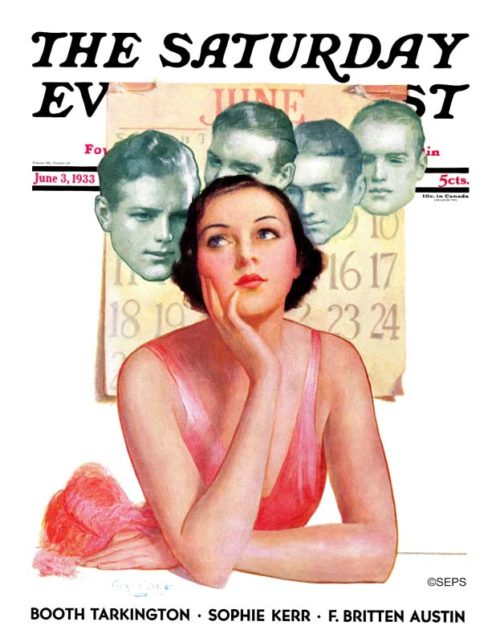
George W. Gage
June 3, 1933
With so many suitors, it’s easy to see why this beauty is beyond vacillating among valentines.
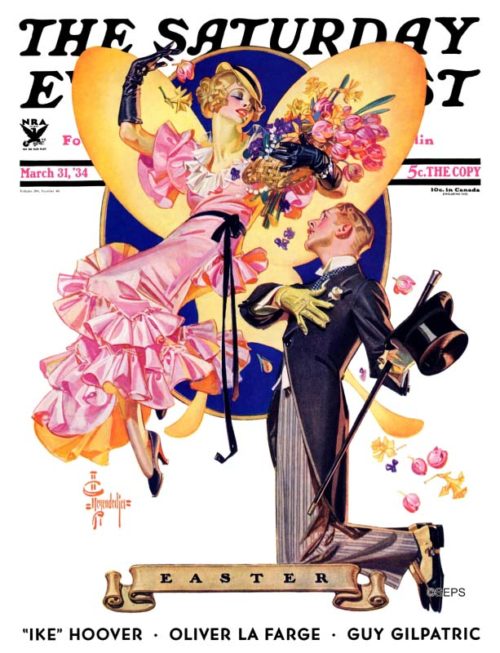
J. C. Leyendecker
March 31, 1934
A pretty pink dress, fresh flowers, and a gentleman with a top hat — the makings of a rousing rendezvous.
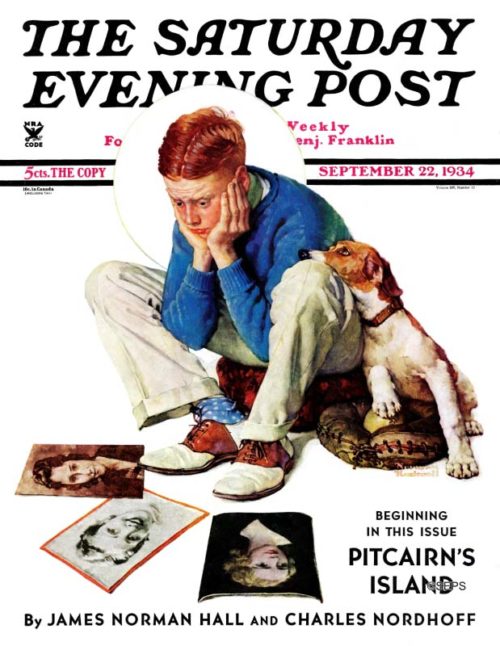
Norman Rockwell
September 22, 1934
A bounty of beauties has left this lad with a lot to think about.
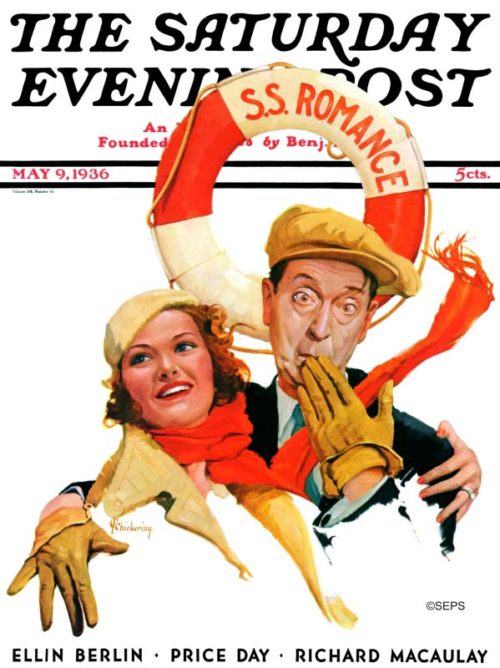
Charles R. Chickering
May 9, 1936
Nothing says a scenic getaway for two like a sea-bound voyage.
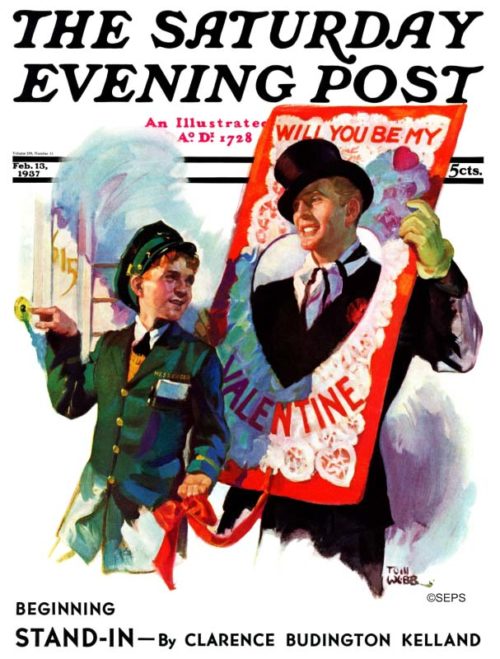
Tom Webb
February 13, 1937
For this well-dressed fella, finding true love starts with a colossal card.
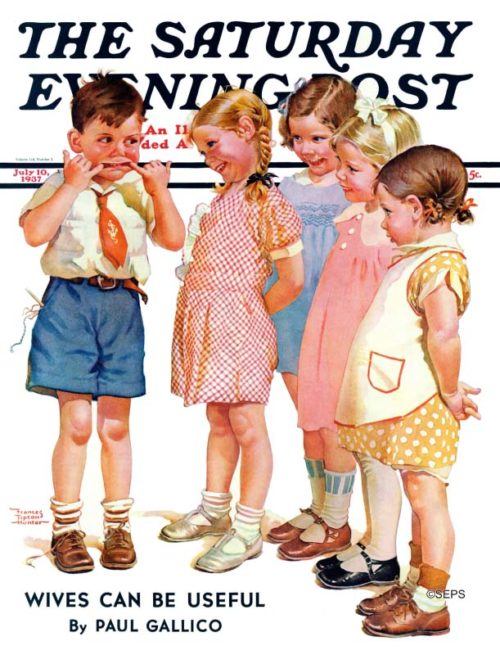
Frances Tipton Hunter
July 10, 1937
Making faces works wonders when you’re five, but soon our larkish lad will need to find new ways of wooing.
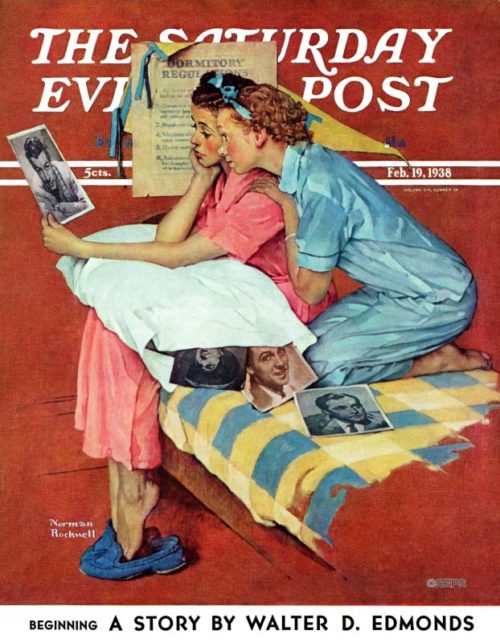
Norman Rockwell
February 19, 1938
Gawking over a gorgeous guy is always sure-fire entertainment for any sleepover.
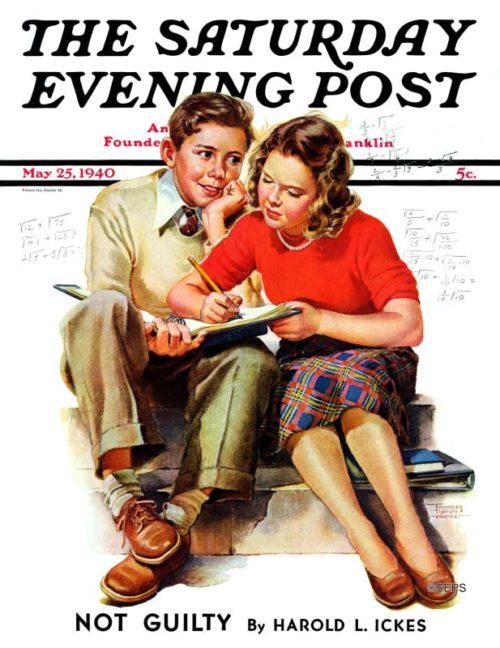
Frances Tipton Hunter
May 25, 1940
This boy is doing more longing than long-divisioning.
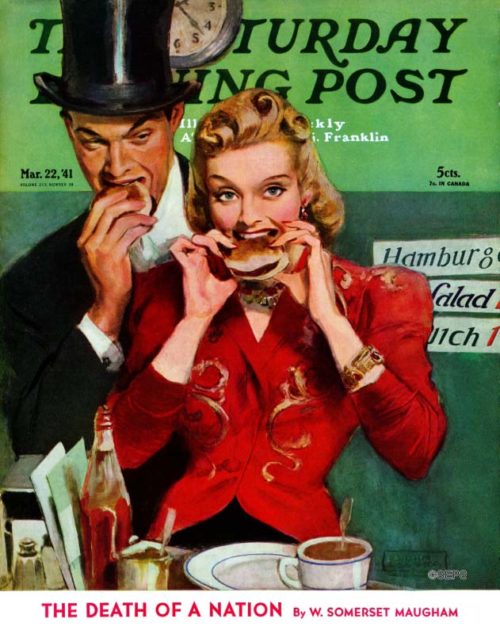
John LaGatta
March 22, 1941
This well-dressed duo dashes off to a diner for a cup of joe and juicy burgers.
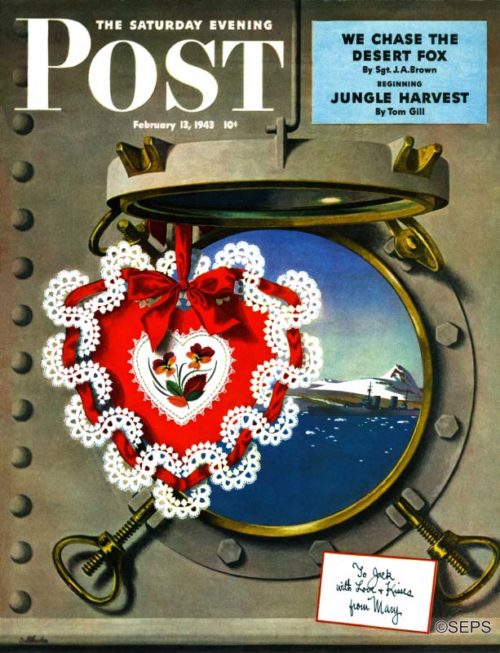
John Atherton
February 13, 1943
Distance makes the heart grow fonder, especially when you’re separated by nothing but sea.
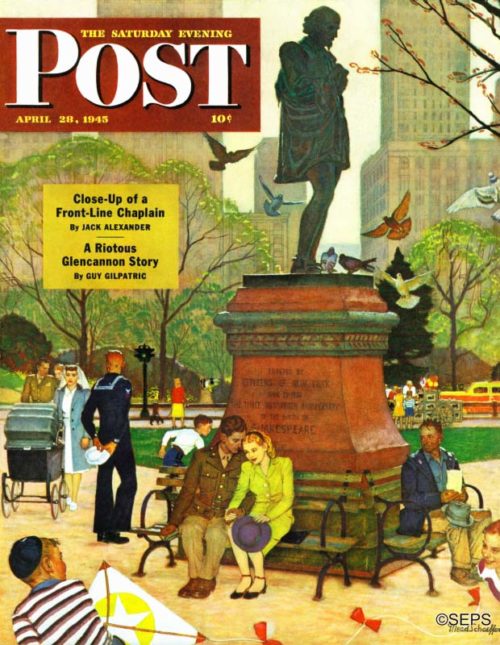
Mead Schaeffer
April 28, 1945
Forget the extravagant getaways — an afternoon stroll in the park works perfectly for this lovely pair.
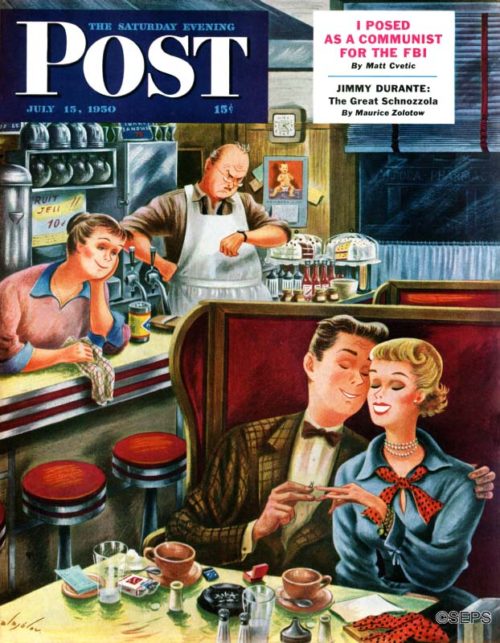
Constantin Alajalov
July 15, 1950
After doors are locked, this lad and his lady linger, perhaps a bit too long.
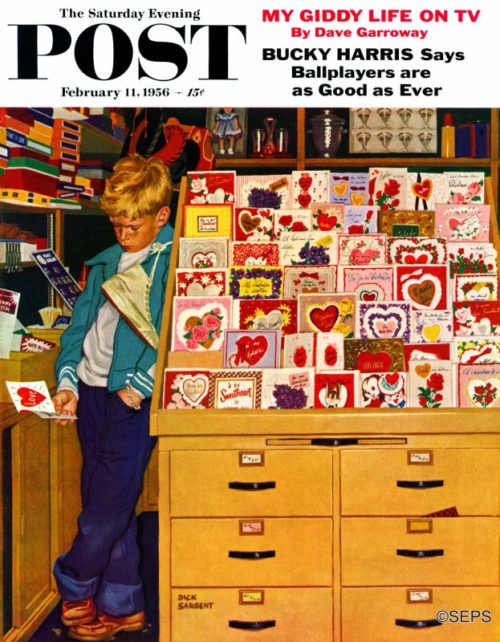
Richard Sargent
February 11, 1956
Picking a V-Day card takes time, especially when she’s your first love.
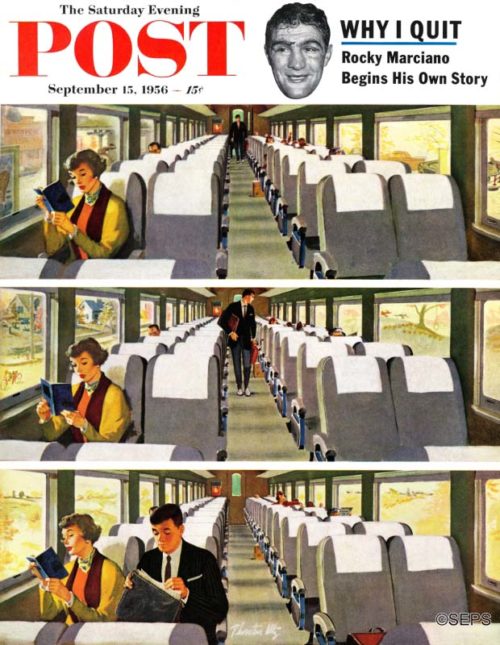
Thornton Utz
September 15, 1956
This gentleman wasn’t shy about chasing down his dream girl.
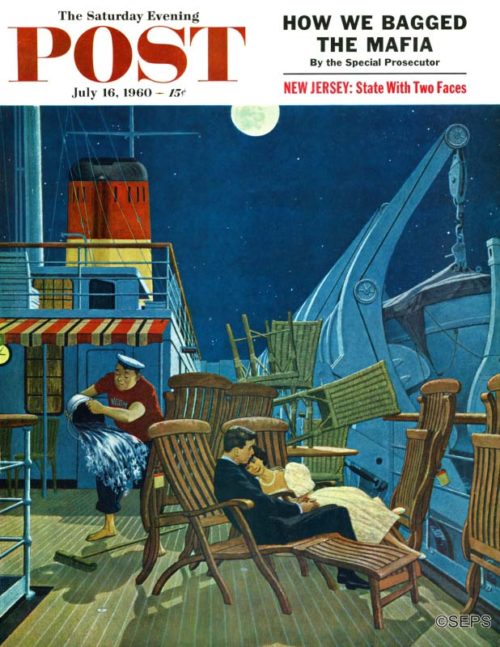
James Williamson
July 16, 1960
This crew member is about to make this crowded corner is a less-than-ideal location for these love birds.
Cover Gallery: Presidents
The Saturday Evening Post has featured many U.S. presidents on its cover in its nearly 200-year history. Here is a gallery of the men who have helped shape our nation.
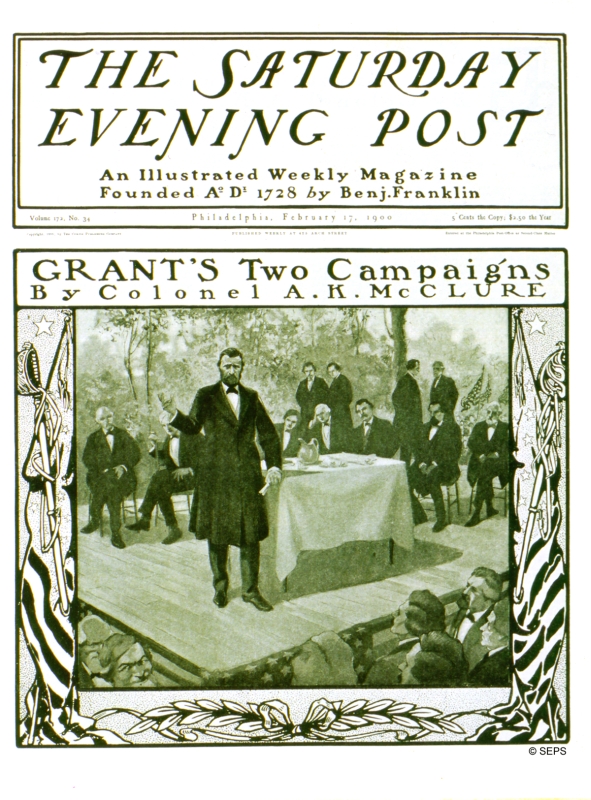
By Karl Kleinschmidt
February 17, 1900
Fifteen years after his death and 23 years after leaving office, Grant appeared on the cover of the Post, in one of a series of articles by Colonel A. K. McClure on “How We Make Presidents.” Grant oversaw the elimination of Confederate nationalism and slavery, protected African-American citizenship, and supported industrial expansion.
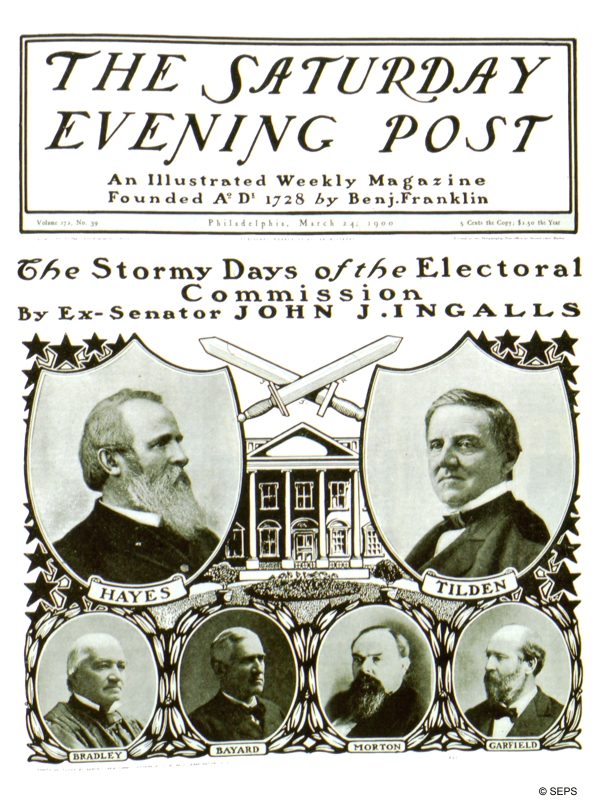
By Sarony & Bell
March 24, 1900
The election of 1876 was one of the most contentious in U. S. history. It was one of only five elections in which the person who won the most popular votes did not win the election. At one point, Tilden had 19 more electoral votes than Hayes. But a deal was brokered in which 20 disputed electoral votes were awarded to Hayes in exchange for withdrawal of federal troops from the South, putting Hayes in the White House by one vote.
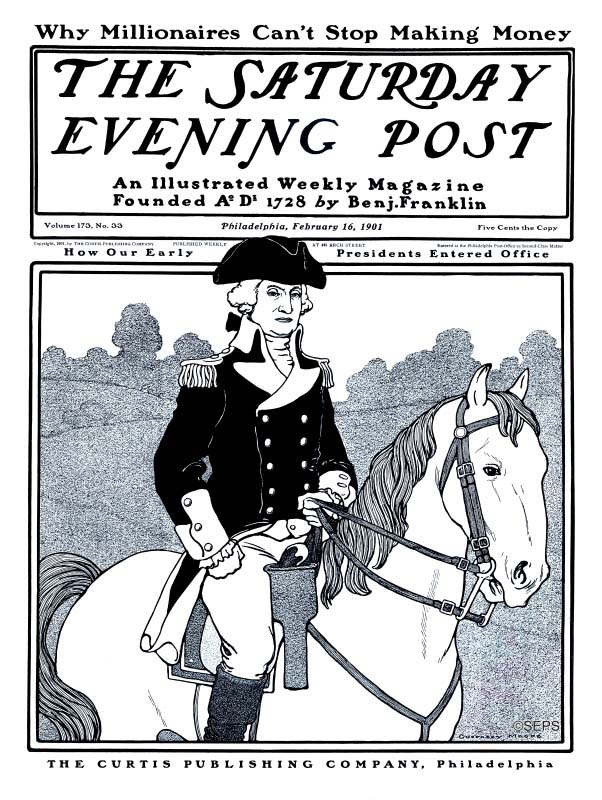
By Guernsey Moore
February 16, 1901
As he was handing over the reins of the presidency to his successor, John Adams, Washington wrote, “I hold the maxim no less applicable to public than to private affairs, that honesty is always the best policy.”
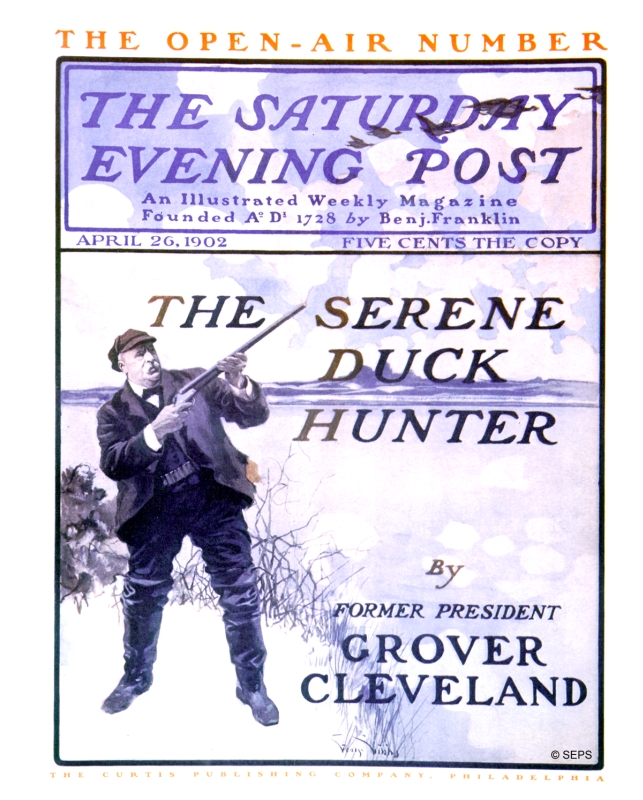
By George Gibbs
April 26, 1902
Grover Cleveland was only U. S. President to serve two non-consecutive terms in office. He appeared on seven Saturday Evening Post covers and wrote several articles for the magazine on hunting, fishing, and the plight of democracy (not necessarily in that order of importance). He is remembered for being the only president to marry while in the White House, and for his deathless statement, “What is the use of being elected or re-elected unless you stand for something?”
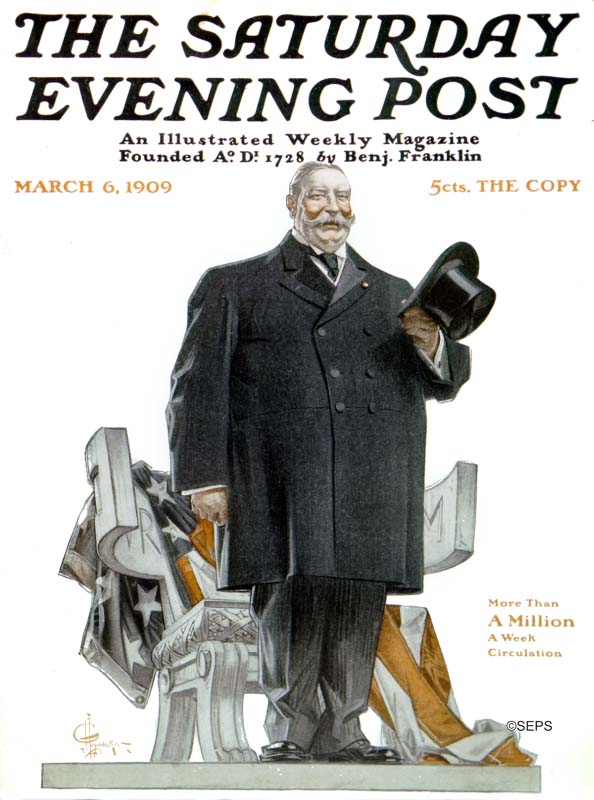
By J. C. Leyendecker
March 6, 1909
An article in this issue of the Post proclaimed Taft to be “the heaviest President, the most traveled President, the best-natured President and the first golf player to occupy the White House.” He was among the most amiable and least ambitious men to be elected to the office. He continued most of the policies of his predecessor and friend, Teddy Roosevelt, but the two became estranged and ran against each other in 1912.
All his life, Taft tried in vain to reduce his weight. He reached 355 pounds while he served unhappily as president. He was also the only president to also serve as a justice on the Supreme Court, where he was far happier.
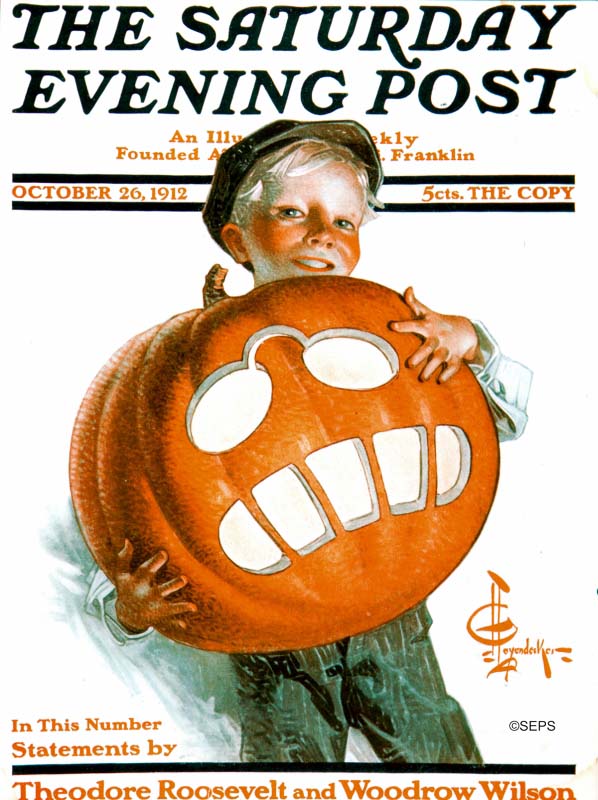
By J. C. Leyendecker
October 26, 1912
The Post was fascinated and charmed by Theodore Roosevelt, an energetic, progressive, young president who interrupted the long line of serious old men in the White House. Post editorials applauded his campaigns against “malefactors of great wealth” and his enthusiasm for making the U.S. a global power. Coming to the presidency in 1901 after President McKinley was shot, he was elected to a full term in 1904. He stepped aside in 1908 to let his friend, William H. Taft, successfully run for office. But in 1912, when this boy carved his pumpkin with TR’s toothy grimace and pince nez glasses, he was trying unsuccessfully for another term.
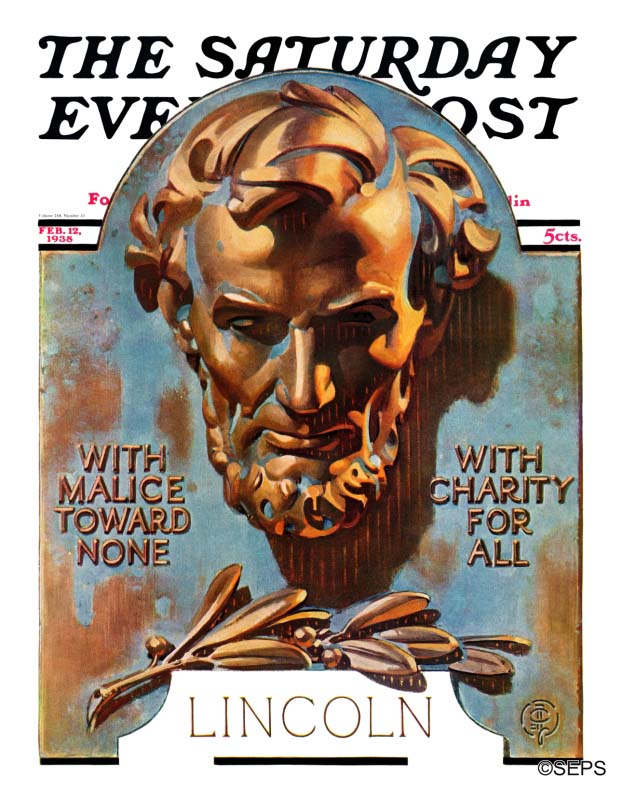
By J. C. Leyendecker
February 12, 1938
In 1862, with the country at the end of a Civil War, Lincoln called on Americans to face the challenges ahead without looking backward. He also reminded members of Congress that they would all be remembered for what they did in those perilous times:
“The dogmas of the quiet past, are inadequate to the stormy present. The occasion is piled high with difficulty, and we must rise — with the occasion. As our case is new, so we must think anew, and act anew. We must disenthrall ourselves, and then we shall save our country.
“Fellow-citizens, we cannot escape history. We of this Congress and this administration, will be remembered in spite of ourselves. No personal significance, or insignificance, can spare one or another of us. The fiery trial through which we pass, will light us down, in honor or dishonor, to the latest generation.”
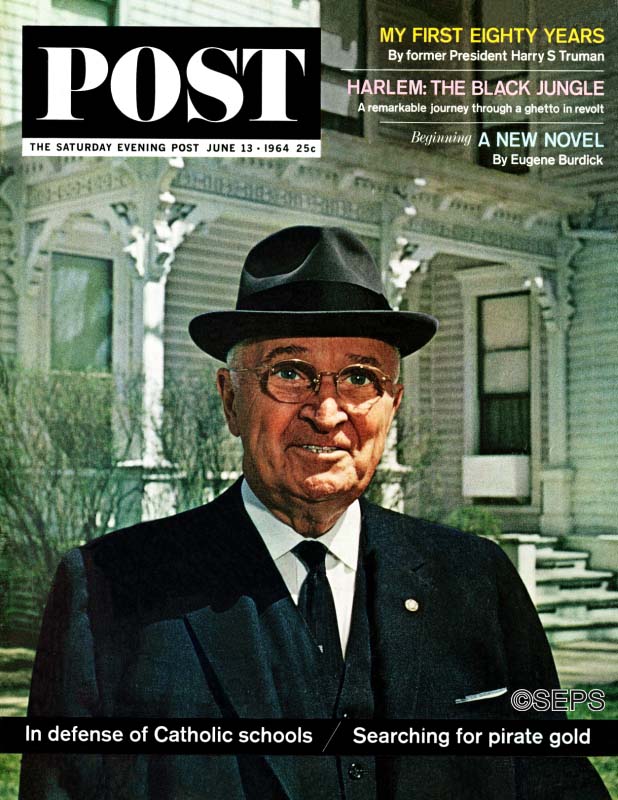
By John Launois
June 13, 1964
This photograph of former President Truman was taken in front of his Independence, Missouri home. In an article that Truman wrote for the Post, the 80-year-old looked back over his controversial career and explained the principles that guided him in making the most difficult decisions of his Administration — including the “firing” of Douglas MacArthur.
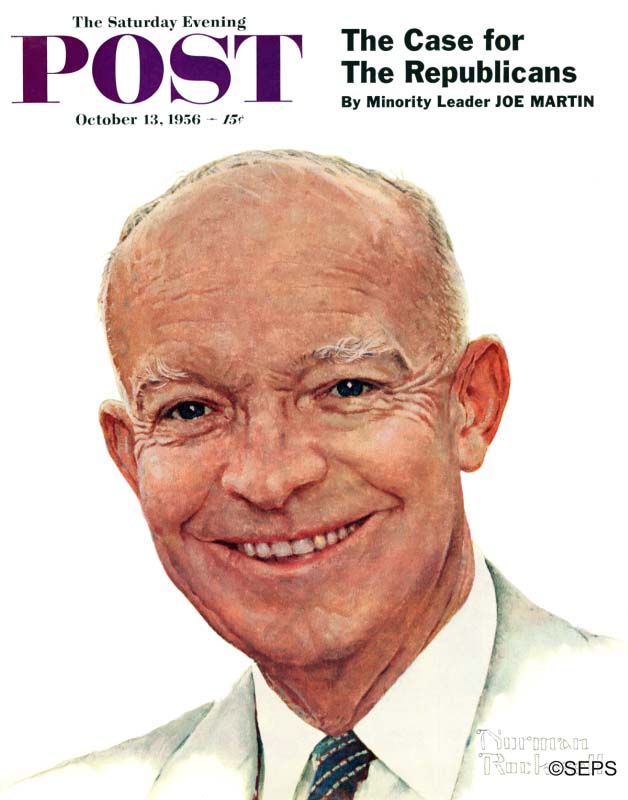
By Norman Rockwell
October 13, 1956
The Post hadn’t featured a sitting president on its cover since Taft’s appearance in 1909. A popular president, Eisenhower authorized the establishment of NASA, invoked executive privilege to help end McCarthyism, expanded social security, launched the interstate highway system, and established the Defense Advanced Research Projects Agency which led to the development of computer networking and graphical user interfaces.
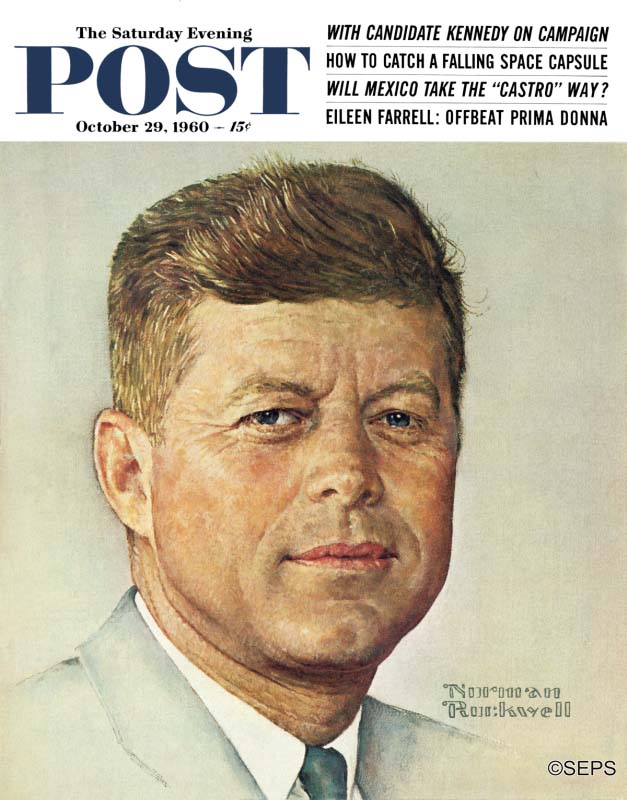
By Norman Rockwell
October 29, 1960
Among his many better known accomplishments, Kennedy also won a Pulitzer Prize (for “Profiles in Courage”), was awarded a Purple Heart, and donated his salary to charity. He represented the new generation of politicians: he was young, good-looking, smart, and funny, and drew international admiration. Kennedy spoke of idealism at a time when the country wanted to move on to new horizons, but his aggressive stance against communism brought the country close to one war and involved it in another, in Vietnam.
This Rockwell portrait appeared a second time when the Post ran its memorial issue after Kennedy’s assassination.
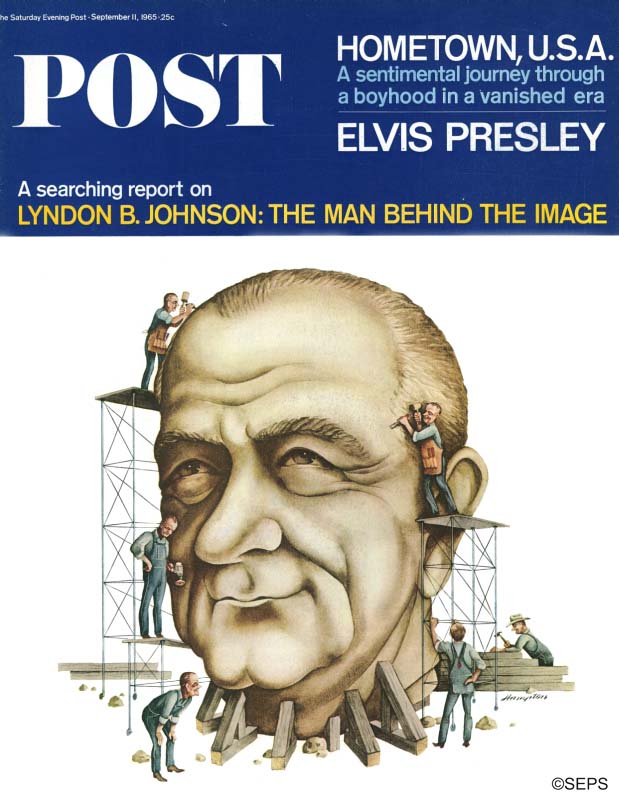
By Blake Hampton
September 11, 1965
President Johnson was a politician’s politician, and he was a paradox. He was cynical and calculating enough to be a powerful force in Washington, but also a champion of the poor and the man who launched a “War on Poverty. Johnson signed several civil rights bills that banned racial discrimination in public facilities, interstate commerce, the workplace, and housing. He signed the Voting Rights Act and the Immigration and Nationality Act into law. When he came to the White House after Kennedy’s assassination, he enjoyed a long honeymoon period with the press. But he lost the support of the media, and many Americans, with his determination to continue sending American soldiers to Vietnam.
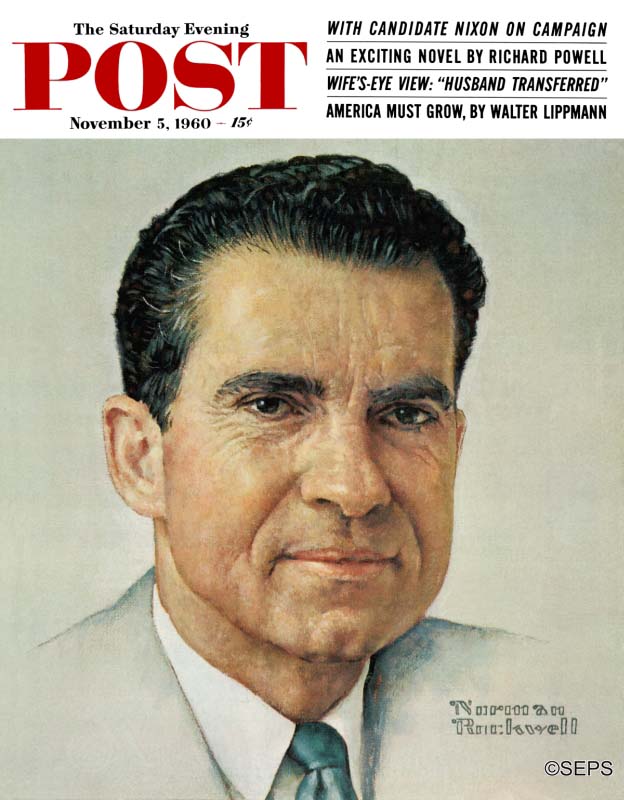
By Norman Rockwell
November 5, 1960
President Nixon is best remembered for the Watergate scandal and his subsequent resignation, but he also opened diplomatic relations with China, initiated détente with the Soviet Union, and established the Environmental Protection Agency. He ended U.S. involvement in Vietnam, and supported the Equal Rights Amendment, affirmative action, and the food stamp program. It was ironic that a man who rose in politics through his anti-communist stance made such significant progress with the communist governments of Russia and China.
Rockwell painted this portrait of candidate Nixon nine years before Nixon won the presidency.
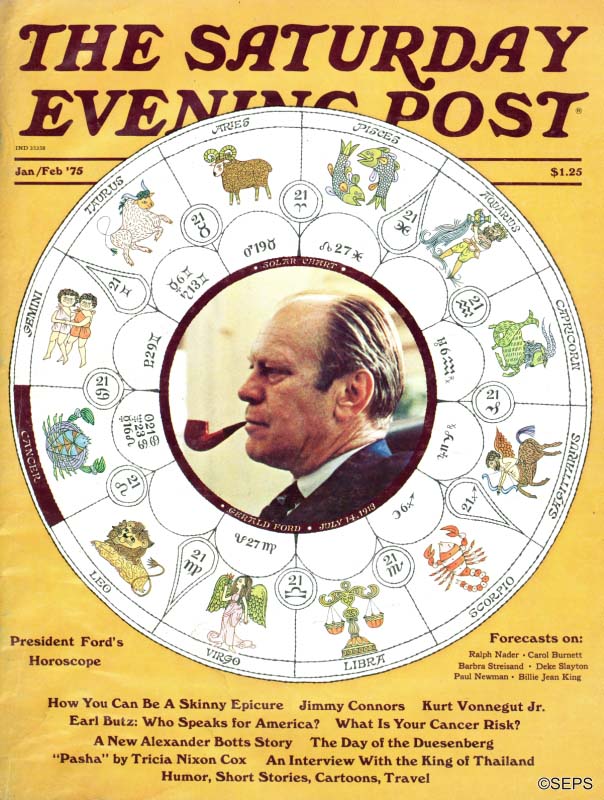
By J. Moore
January 1, 1975
In this feature in the Post, “astrologer to the stars” Carroll Righter analyzed President Ford’s astrological profile, terming him a Moonchild. Ford has the distinction of being the only person to have served as both Vice President and President of the United States without being elected to either office. It has not been determined if the alignment of the stars or planets was a factor.
Entering the White House abruptly when President Nixon resigned, he drew broad support by pardoning the men who’d avoided serving in Vietnam by illegally dodging the draft. But much of his popularity melted away when he also pardoned Nixon, sparing the nation a long, rancorous, divisive spectacle of a trial.
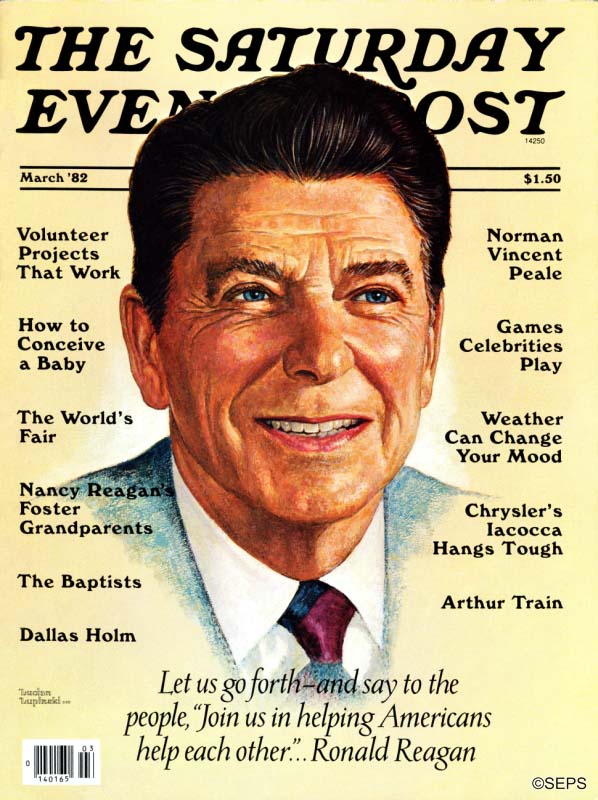
By Lucian Lupinski
March 1, 1982
Once a Democrat, Reagan switched to the Republican party as his views became more conservative. As president, he supported Afghan rebels opposing Russia’s invasion of their land and pushed for a space-based missile system to protect America from a nuclear attack. In the end, though, he was the president whose policies and tactful diplomacy with Russian leaders would end the Cold War.
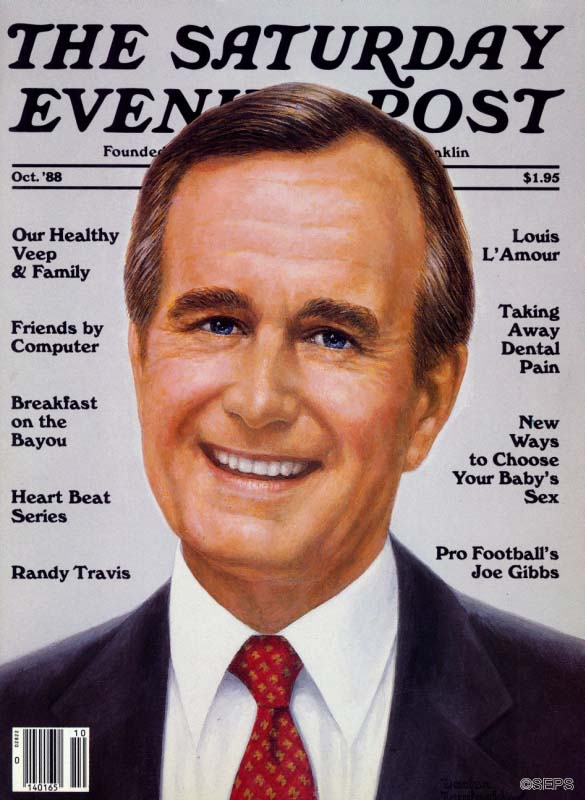
By Lucian Lupinski
October 1, 1988
George H. W. Bush appeared on the Post cover when he was still vice president, but was poised to win the presidential election, held a month later. He is the oldest living former president and vice president.
Bush continued many of Reagan’s policies, but he bridled when journalists compared him unfavorably to the charismatic Reagan. He was portrayed by some as being weak, sheltered, and a wimp. Yet it was Bush, not Reagan, who served in World War II and survived being shot down as a Navy pilot. His single term was noted for his authorization of the military overthrow of a corrupt dictator in Panama and the smashing of Iraq’s force in Kuwait though Operation Desert Storm.
Cover Gallery: Let It Snow!
The Saturday Evening Post loves a beautiful snowy day! (As long as we don’t have to drive anywhere. And it doesn’t turn to ice. And it’s not too cold. And it won’t last three more months. You get the idea.) Depending on your attitude toward frozen water, you’ll either love or loathe our cover gallery of winter fun, all from Post issues published before 1920.
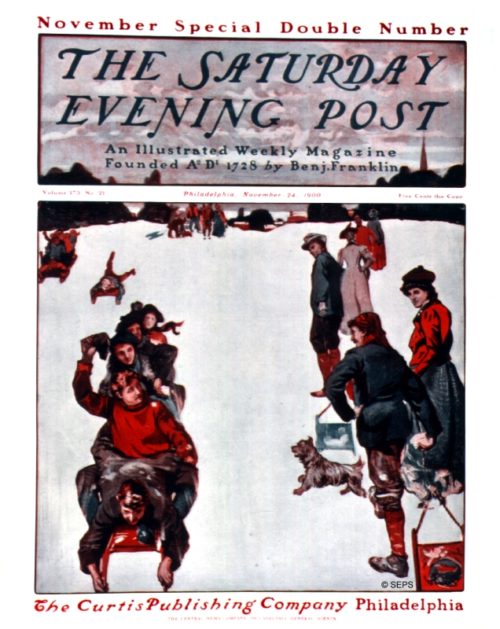
George Gibbs
November 24, 1900
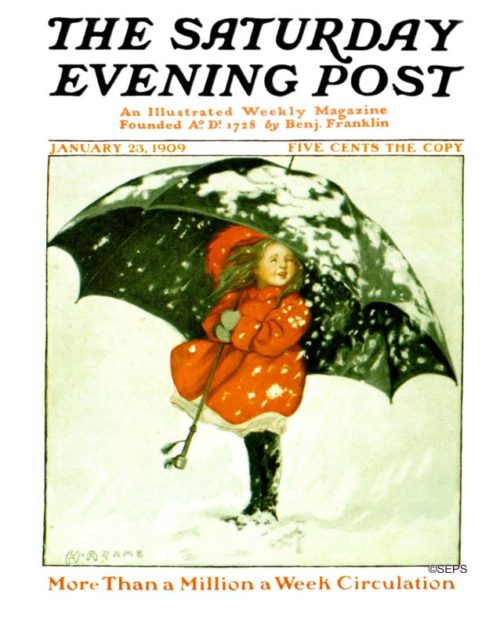
Henrietta Adams
January 23, 1909
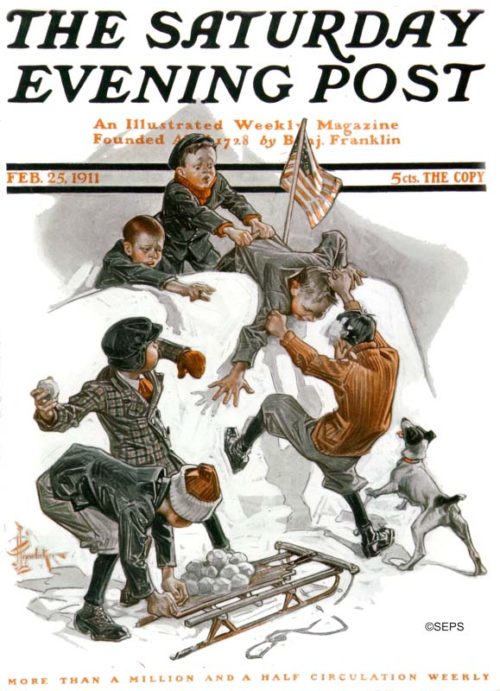
J. C. Leyendecker
February 25, 1911
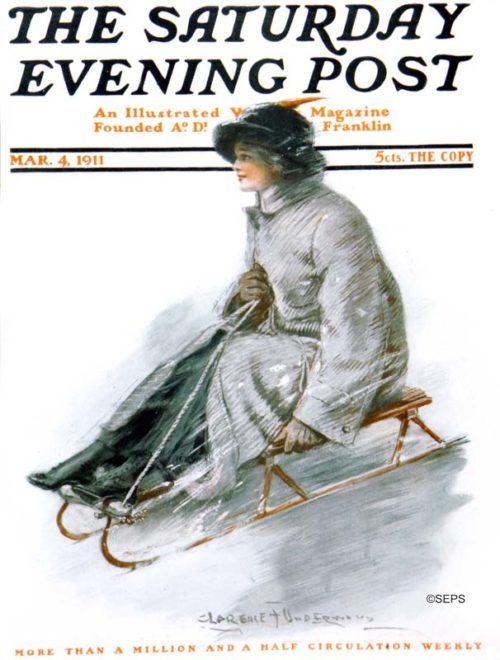
Clarence F. Underwood
March 4, 1911
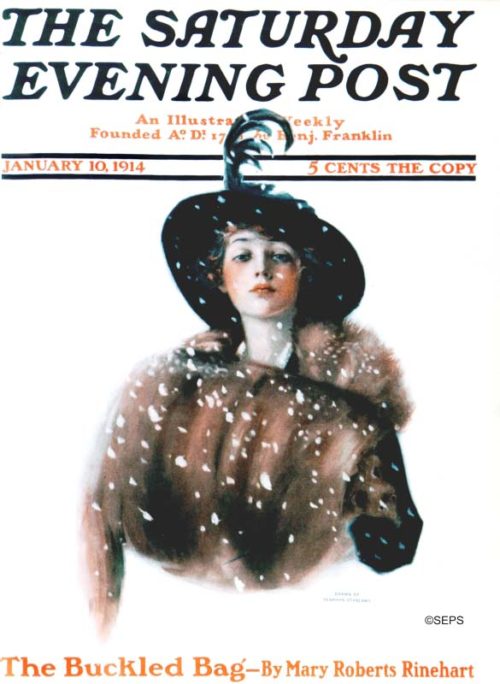
Penrhyn Stanlaws
January 10, 1914
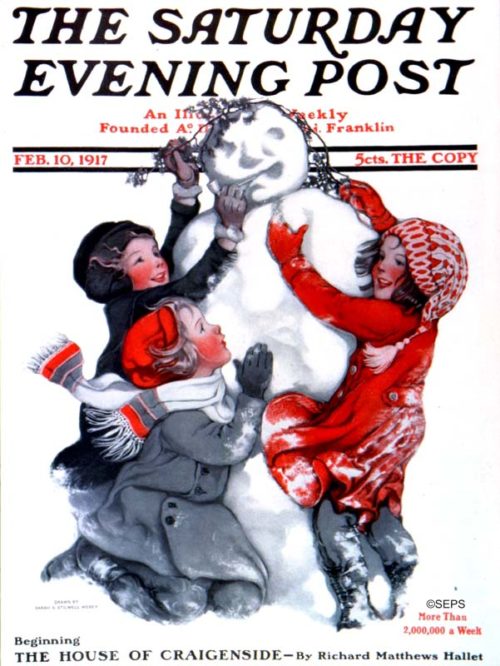
Sarah Stilwell-Weber
February 10, 1917
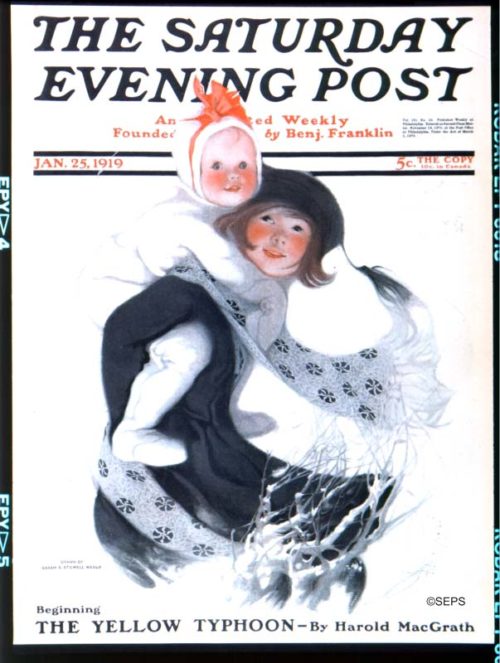
Sarah Stilwell-Weber
January 25, 1919
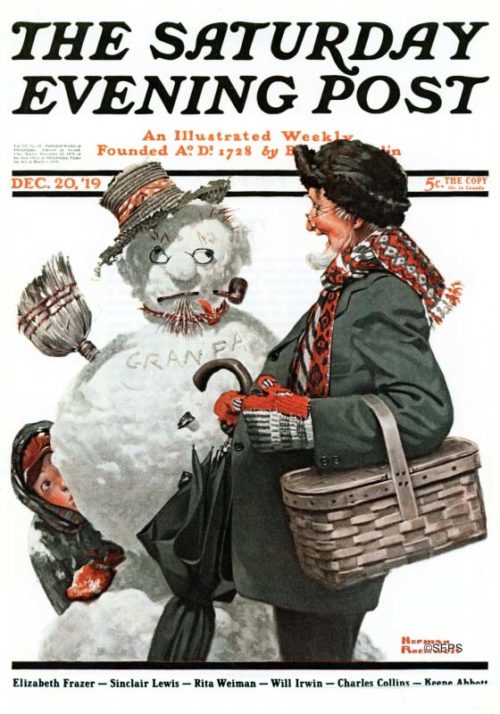
Norman Rockwell
December 20, 1919
A Salute to Veterans
Tributes to the military have long been portrayed on covers of The Saturday Evening Post, from situations serious to humorous. In honor of Veterans Day, we would like to share some of our favorites.
The first Post military cover? An action depiction of U.S. soldiers on horseback in the Philippines.
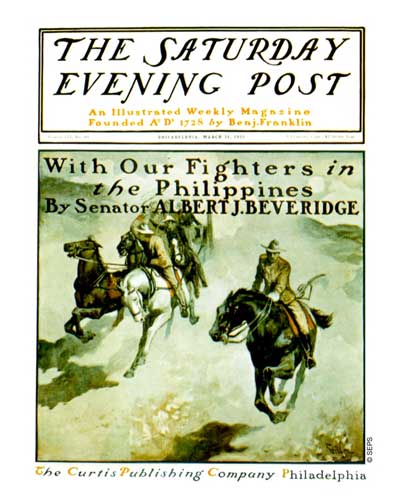
George Gibbs
March 31, 1900
He’s in the Army now. A seldom seen cover from December 1942 by John Atherton shows a faithful dog and a photo. From the uniform, we can guess where its master is. We hope he returns home soon – Spot is itching to go hunting.
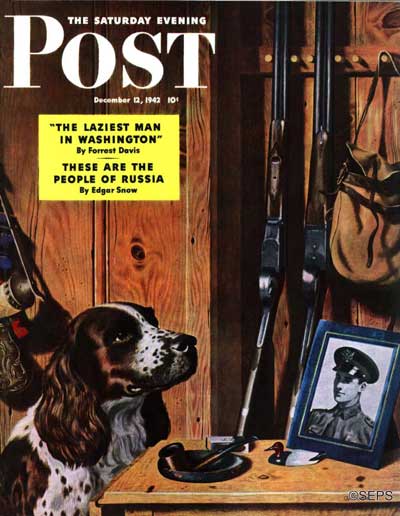
John Atherton
December 12, 1942
The enlisted also included members of the Women’s Army Corps (WAC), as shown in the cover from 1942 by an artist named Gilbert Bundy.
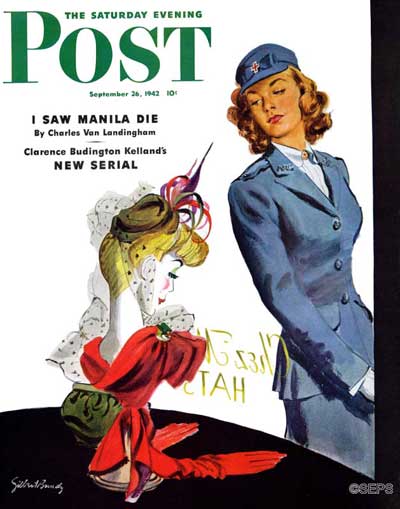
Gilbert Bundy
September 26, 1942
A WWI soldier shares a humble Christmas meal in this endearing 1917 cover by the prolific J.C. Leyendecker.

J. C. Leyendecker
December 22, 1917
On the May 14, 1927, cover by E.M. Jackson, this sailor accomplishes an important mission overseas — finding a genuine American hot dog!

E.M. Jackson
May 14, 1927
Celebrating soldiers, sailors, and marines, the 1937 cover by John Sheridan captures all three with a parade below in their honor.

John Sheridan
November 13, 1937
Norman Rockwell honored the military during the WWII years with several covers of the “every soldier” he named Willie Gillis. We’ve shown Willie’s military adventures before, but not this one from 1941. Rockwell’s famous private is home on leave, snuggled under the quilts and enjoying the luxury of sleeping late. The sign above the bed echoes our ardent wish for all our military men and women: Home Sweet Home.

Norman Rockwell
November 29, 1941
After Forest Gump, actor Gary Sinise became an advocate for wounded soldiers. Check out Jeanne Wolf’s interview with Sinise from the September/October 2014 issue here.

John Jay Cabuay
September/October 2014
The Art of the Post
When it came to The Saturday Evening Post, George Horace Lorimer had it covered. The legendary editor-in-chief gave the Post its first cover in 1899, and hand-picked every one thereafter for the next 30 years. Some ideas came from editors, and occasionally even readers wrote in with suggestions that made it to the cover. Mostly, though, it was the artists of the day who presented their ideas to Lorimer, in sketches and fully rendered paintings. It was a moment of mingled excitement and terror as Lorimer, “the Boss,” lined up cover prospects along a wall, then rapidly accepted or rejected illustrations with the flick of a finger. His word was final, but his judgment was unerring, as you’ll see in this gallery of Post covers.
N. C. Wyeth

November 30, 1997
N. C. Wyeth
The father of painter Andrew Wyeth and grandfather of present-day artist Jamie Wyeth, Newell Convers Wyeth was a student of Howard Pyle and the Brandywine School of art. Wyeth’s first professional work was a commissioned illustration for the Post. His sense of color and mood was particularly suited to Western subjects, which also appealed to Lorimer. So the Post sent Wyeth to gain firsthand knowledge of his subject. On trips to the western United States, he worked as a ranch hand in Colorado and rode mail routes in New Mexico and Arizona.
Charles Livingston Bull

Charles Livingston Bull
September 9, 1905
Known chiefly as an animal illustrator, Bull literally drew from his experience as a taxidermist at the National Museum in Washington, D.C. Bull’s images, whether an eagle soaring in flight or a fox on the prowl, gave a majestic, even startling, life and grace to his wild subjects.
Angus MacDonall

October 8, 1921
MacDonall, who came from the Midwest but eventually migrated east to become part of the Westport, Connecticut art colony, did only a few covers for the Post, but they were memorable, especially his poignant depictions of children. The forlorn boy and his dog were real, seen by a reader in Oregon, who described the scene vividly in a letter to the editor.
Ellen Pyle

Ellen Pyle
August 12, 1922
Like N.C. Wyeth, Ellen Bernard Thompson Pyle was a student of Howard Pyle’s Brandywine School, later marrying Howard’s brother Walter. When they started a family, Pyle set painting aside, but after Walter’s death in 1919, as a widow with four children, Pyle resumed her career to make ends meet. She struggled at first, but then her sister-in-law took three of Pyle’s paintings to the Post—and Lorimer promptly bought two of them, in addition to the girl with the ice cream cone, which became a cover in 1922 (after Lorimer insisted that the dog, originally shown drooling, be retouched). Pyle painted 40 Post covers in all, often using her children as models. The girls sipping sodas here are Pyle’s daughters.
J. C. Leyendecker

J. C. Leyendecker
February 25, 1933
Joseph Christian Leyendecker received his first commission to paint a Post cover the same year George Horace Lorimer began running them, in 1899. Before Norman Rockwell arrived, no other artist had been so closely identified with the Post. Leyendecker famously created the iconic New Year’s Baby and the pudgy red-garbed rendition of Santa Claus, among other enduring images. Rockwell himself idolized the artist, calling him “a superb draftsman and a fine colorist,” as evidenced here. Leyendecker had an eye for the humor in everyday life, too (as in the case of the ample bathing beauty and her water wings, witnessed by a Post editor, who later described her to Leyendecker), which always delighted readers.
For more cover art, visit saturdayeveningpostcovers.com.